Have you ever felt like you’re playing catch-up in the vast digital landscape? I remember when I first got an idea of what SEO really is, gazing enviously at my competitors who seemed to have it all figured out. One particular instance stands out - when I stumbled upon the concept of backlink gap analysis. It was a lightbulb moment that transformed the way I approached my marketing strategy. Today, I want to share that enlightening experience with you and help you tackle the complexities of backlink gap analysis. Are you ready to explore more? Let's dig dipper about this effective SEO technique.
TL;DR: Learn how to conduct a backlink gap analysis that will elevate your website's SEO by identifying valuable backlinks that your competitors possess but you lack.
To give you an overview, a backlink gap analysis is a method used to evaluate the backlinks of competitors. Basically, it looks at which links they have that your site does not. Think of it like looking through someone else's recipe book. You want to see what ingredients they use that you haven't yet considered. Understanding these factors helps you create a more competitive online presence.
Why does this matter for your SEO strategy? Well, backlinks are a crucial factor in how search engines like Google rank sites. The more quality backlinks you have, the better your chances of ranking higher. It’s like building credibility. If credible sites link to you, it signals to search engines that you provide valuable content.
When conducting a backlink gap analysis, we can directly see how it affects our site's search ranking. If your competitors have significant backlinks pointing to their sites but you lack these, you're at a disadvantage. Each missing link is like a missed opportunity to reach potential customers. According to Boron from Osborne Digital Marketing, "If a competitor is good at finding relevant backlinks and your website lacks them, it places you at a disadvantage." That's something we need to take seriously.
Backlink gap analysis isn’t the only technique in the SEO toolkit. But it stands out. While techniques like keyword optimization, proper anchor text, and content marketing are pivotal, they don’t directly improve your site's performance. In this case, backlinks play a fundamental role. They are like votes of confidence from other sites, signaling to search engines that your content is worth ranking. In comparison, on-page SEO focuses more on content and metadata but doesn’t encompass the external credibility that backlinks provide.
There are certainly some misconceptions surrounding backlink analysis. One common myth is that quantity matters more than quality. In reality, having a few high-quality backlinks is far more beneficial than many low-quality ones. Another misconception is the idea that once you've done the analysis, you’re done. Not at all! This is an ongoing process. Regularly reviewing and adjusting your backlink strategy based on market shifts and competitor changes is key to sustained success.
In our pursuit of better SEO, this analysis serves as a vital tool. It helps draw a clearer picture of where we stand against our competitors and identifies actionable insights to improve our backlink strategy. Are you ready to find your backlink opportunities?
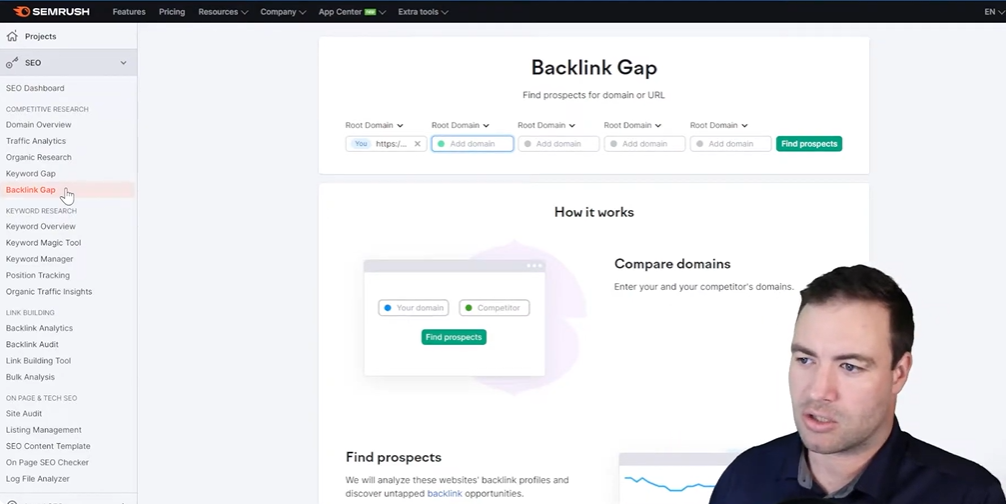
When looking into SEO, having the right tools is essential. There are numerous SEO tools available, each offering unique features that can help us analyze our websites. Some popular ones include Ahrefs, Moz, and SEMrush. Each of these tools provides insights into keyword rankings, backlink profiles, and site audits. But as I’ve explored these options, I consistently find myself leaning toward SEMrush. Ahrefs has ans SEO API feature for easy SEO automation.
So what makes SEMrush a standout choice for a backlink gap analyzer for me? It's simple: comprehensive features and user-friendly interface. While other tools can be powerful, they often overwhelm users with complex layouts and terminology. SEMrush feels intuitive. It presents data in a way that's clear and actionable. It's like having a friendly guide on a sometimes-overwhelming journey.
Getting started with SEMrush is straightforward. Here’s how I usually do it:
By following this approach, I can easily track my backlink's performance and see where I need to improve.
It’s worth noting that there is always a learning curve with new tools like SEMrush. I remember the first time I used it; it felt a bit daunting. But don't worry, the more you play around with the features, the easier it becomes. My advice? Spend some time with the tutorials offered by SEMrush. They break down complex concepts into bite-sized pieces that are easy to digest.
And remember, mastering any tool takes patience. Just like learning to ride a bike, it may feel wobbly at first, but with practice, it becomes second nature.

When I first set out to conduct an analysis, I felt overwhelmed. So many metrics, so many competitors! But I learned it can be broken down into manageable steps. Here’s how you can perform your analysis:
Choosing the right competitors is crucial. I find it helpful to think about competitors who not only operate in the same niche but also rank well for the keywords you’re targeting. After all, what’s the point of analyzing someone who doesn’t compete with you?
Now that we have the data, how do we interpret these long list o numbers? Each backlink contributes to domain authority. By comparing these list of numbers, you will see potential areas for growth. For instance, if a competitor has 300 backlinks and you only have 100, there’s a clear difference!
“Understanding these dynamics is crucial for effective SEO strategies.” – Boron, Osborne Digital Marketing
Not all backlinks are created equal. Here’s how I discern valuable links:
Backlink analysis can be time-consuming. I recommend setting aside specific times for this task. Here’s what works for me:
You can master this essential aspect of SEO with a systematic approach. Don't feel discouraged; every successful analysis takes practice!
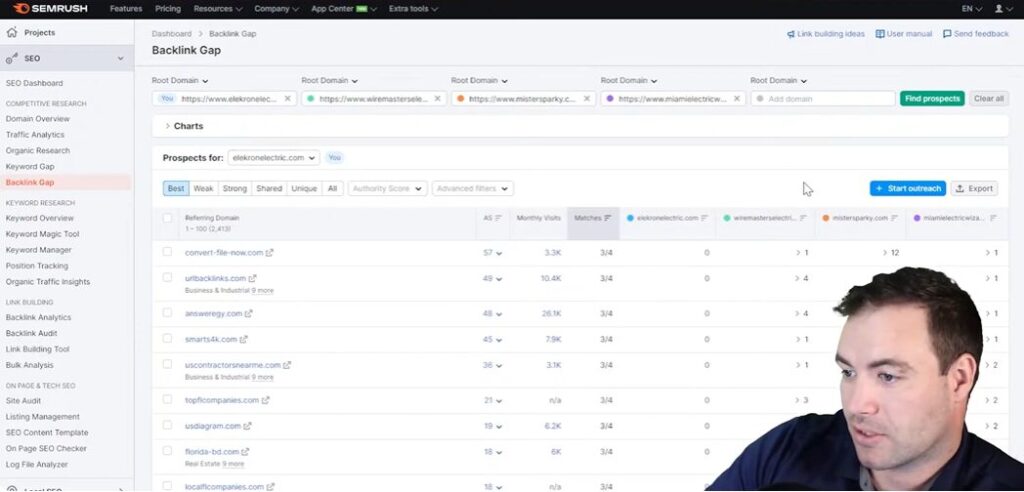
When we think about improving our website's ranking, we often wonder: how can we use competitor data to our advantage? One effective method is analyzing their backlink profiles. This process not only reveals their strengths but also highlights opportunities for us to grow.
Strategically leveraging what our business competitors do well can give us a significant edge. Start by identifying the top competitors in your niche by using a backlink profile checker. Next, use a reliable SEO tool like SEMrush, Ahrefs, Rank Lightning, and Majestic SEO to evaluate their backlinks. What links or URLs do they have that you don’t? This is often referred to as a back link gap analysis. SEMrush creates a list of referring domains that links to specific websites. It helps pinpoint valuable websites that you might want to reach out to for your own backlinks. Most of these SEO tools offer free usage. Just choose the right platform for your concerns and needs.
Not all backlinks are created equal. Here are some common attributes to consider:
Being aware of these attributes can help assess whether a backlink will truly benefit your site’s SEO. Make it the center of your priority to learn more about these attributes.
The terms domain authority and page authority can be a bit confusing. In short, domain authority relates to the overall strength of a website while page authority focuses on a specific page. A high domain authority often indicates better chances of ranking higher in search results, making it a crucial metric to consider.
We are often tempted to chase after any backlink opportunity that comes our way. However, it’s essential to focus on high-quality links. A single link from a reputable site can outweigh multiple low-quality links. But how do we know if a link is low quality? Look out for:
Some backlinks can actually harm your website’s authority. For instance, avoid links coming from link farms or low-quality directories. If a site has a sudden spike in links, that could also be a red flag. Always remember, quality over quantity is a must in backlinking.
By thorough competitor analysis, we can make informed decisions. Understanding what works for them might just be the key to unlocking new doors for our own site's success!
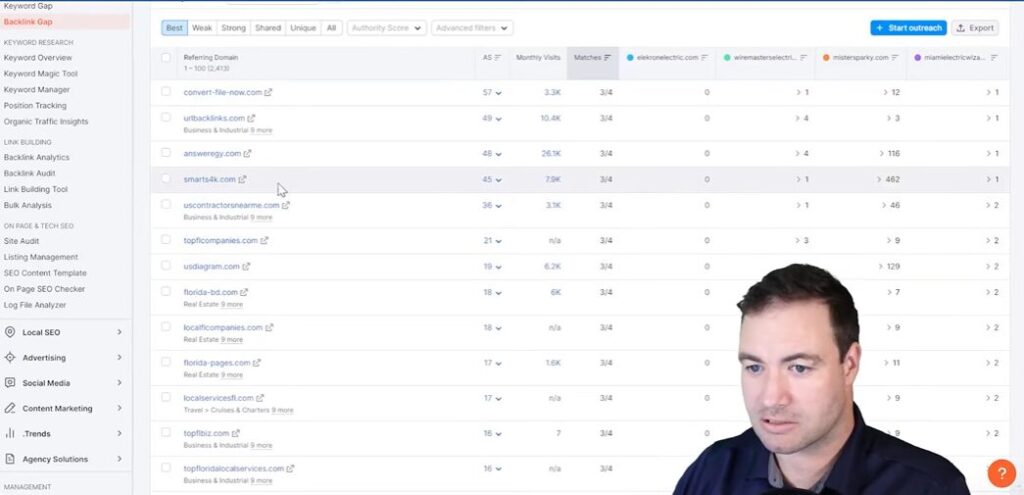
When we talk about outreach, think of it as opening a door. You want to be welcoming, yet direct. Crafting effective outreach emails is a game changer in creating a backlink strategy.
Start with a strong subject line. What’s going to get someone’s attention? Keep it simple and relevant. I often opt for something like, “Quick Question About Your Recent Article” - straightforward, right?
When writing the email, keep it concise. Introduce yourself and your purpose in a few sentences. Establish the connection. Why are you reaching out? Mention something specific they did that you appreciated. This builds rapport.
Don't forget to include a clear call to action. It could be a request for collaboration or feedback. People are far more likely to engage if they understand what you want them to do.
Content is king. But what does that mean? Well, high-quality content naturally attracts backlinks. The more valuable your content is, the more others will want to link to it.
Think of it this way: If you're creating an ultimate guide or a unique case study, others in your industry may link to it out of respect or as a helpful resource. It’s not just about quantity; quality matters.
Guest posting is like an exchange of gifts - you give content, and in return, you get a link back to your site. It’s mutually beneficial.
Start by reaching out to websites in your niche that accept guest posts. Just make sure their content aligns with yours. This isn’t just about backlinks; it’s about establishing relationships within your industry.
Collaborations can also extend beyond guest postings. Consider interviews or co-hosting webinars. These opportunities can foster a connection that leads to more backlinks down the road.
Once you’ve secured backlinks, what’s next? Monitoring is key. Backlinks can change. They may be removed, or their relevance might diminish over time. Using free tools like SEMrush helps streamline this process.
Evaluate the performance of these links. Is traffic coming in? Are they ranking well? I often analyze these metrics monthly, ensuring nothing slips through the cracks.
Your backlink strategy isn’t a one-time endeavor. It needs constant attention. Just like your garden, it requires regular watering and weeding.
Set aside time each month to review your links. Which sources are bringing in traffic? Which aren’t? Make adjustments where necessary. Perhaps there are new websites emerging in your field that deserve your attention.
Keeping your strategy fresh is essential. It reflects the changing nature of your industry and your audience’s needs. Don’t be afraid to pivot!
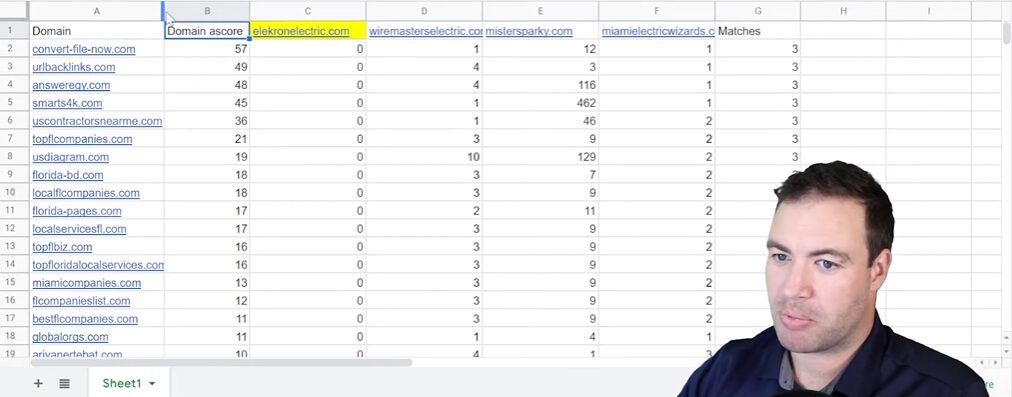
Tracking the effectiveness of your new backlinks is vital. But how do we do it? First, I recommend using tools like SEMrush or Ahrefs. They help monitor not just the presence of backlinks but also their impact. You’ll see how they affect your rankings over time.
To track backlinks, focus on three metrics: link acquisition rate, referral traffic, and keyword rankings. If you notice a spike in traffic following new backlinks, you’re on the right track.
Using analytics is crucial for gauging improvement. Google Analytics is a fantastic yet free tool that is helpful in SEO. It allows us to connect changes in traffic to our backlink strategy. By tracking metrics like session duration and bounce rate, we can understand how engaged our visitors are.
In the world of SEO, continuous learning is essential. Search engine algorithms change constantly. What worked yesterday may not work today. This means we must stay updated.
When was the last time you read about the newest trends? Engaging with SEO communities or following industry blogs can provide fresh insights. It’s like refreshing a garden; we need to keep nurturing our knowledge to grow.
Creating a repeatable process makes everything easier. I suggest laying out a roadmap. Start with data collection. Track backlinks using your preferred SEO tools. Then, assess their performance regularly.
ROI is the name of the game. If a backlink isn’t delivering results, we need to adjust our strategy. Perhaps it’s time to chase links from different sources. Or maybe focus on improving the quality of existing links.
I’ve been there. I’ve chased after links that just don’t pay off. It’s crucial to ask ourselves: Is this strategy worth my time and resources?
By staying flexible and ready to pivot, we can maximize our backlink efforts. This not only enhances our rankings but also boosts our search engine rankings.
As we draw to the end of our exploration into backlinks, I want to take a moment to recap some key points we've discussed. Understanding how to conduct a backlink gap analysis is crucial. It allows us to evaluate not only our own site's backlinks but also those of our true competitors. This enables us to identify solutions for backlink and content gaps that could be impacting our search rankings.
To put it simply, a well-executed analysis can transform your web presence. Imagine standing at the base of a mountain. Your competitors are already at the peak, leveraging all the backlinks they possess. By analyzing these connections, we can find our path to the top. The links that our competitors have can often be the very ones we need to pursue.
Through this analysis, we acquire insights into what's working. This understanding is not static. Rather, it's a continuous cycle of learning and adapting. Are we testing new strategies? Are our efforts yielding results? Regularly revisiting our analysis helps fine-tune our approaches. Just as in any aspect of life, growth comes from ongoing adjustment and responsiveness.
For those just joining the world of SEO, don't be intimidated. Think of backlinks as bridges to your website or your client's. The more solid bridges you build with credible websites, the easier it is for users to find you. And for seasoned professionals, remember to keep an open mind. New tools and techniques continually emerge. Staying updated for your SEO agency is essential.
I invite you to share your insights or experiences with backlink strategies in the comments. Let's learn from each other. Perhaps you’ve discovered a particularly effective method or tool? Your contribution could make a difference for someone else.
In conclusion, embracing the power of backlinks is essential for your link building strategies and online presence. They are more than mere connections; they serve as a testament to your site's value. The journey doesn't need to be lonely. Together, we can master the art of backlinking and watch as our web traffic improves.
Ever felt like you're chasing after the competition in your digital marketing efforts but can’t seem to catch up? I remember when I first started working in the HVAC industry, seeing bigger companies outshine us online felt demotivating. It wasn’t until I discovered keyword gap analysis that everything changed. Instead of merely scrambling to keep up, I learned how to strategically position our services to capture the attention we deserved. In this post, I’m excited to share the ins and outs of performing a keyword gap analysis using SEMrush - a game changer in my SEO strategy.
TL;DR: Learn how to perform a keyword gap analysis with SEMrush to uncover your competitors' strengths and identify opportunities for a more defined SEO strategy.
A keyword gap analysis is an essential tool for anyone involved in SEO. So, what does it actually mean? In simple terms, it is a process of identifying valuable keywords that your competitors rank highly for. This way, we can find areas where we can improve our content strategy. Usually, it happens like a side-by-side comparison between keyword profiles of up to five competitors. It’s like peeking into the next guy’s playbook and applying those insights to our game.
Why is this analysis crucial? Well, first off, it allows us to refine our approach. Knowing what others rank for can uncover potential traffic sources we haven’t considered. Think about it: by understanding our competitors better, we can shape our SEO strategy more effectively.
When we identify these gaps, we can focus on creating content that meets user demands. If we’re savvy about leveraging this tool, our site can climb the SERP quicker, attracting more visitors and potential customers. This is a sign to discover more about this SEO strategy that will surely help your website rank higher.
Let’s break this down further. Conducting a keyword gap analysis reveals content opportunities we might overlook. By analyzing competitors through a report in an organized analysis template, we spot keywords that pull in traffic to your website. This can lead us to create targeted articles tailored to our audience’s needs.
For example, a competitor might be performing well for a keyword like “best HVAC services in Miami.” By discovering this, we can develop content around that keyword and implement it into our website. It's what we call keyword research. This allows us to tap into existing demand.
Moreover, it’s not always about focusing on high-volume keywords. Sometimes, long-tail keywords with lower search volumes can present hidden gems. For instance, keywords with around fifty monthly searches might lead us to write a blog post that resonates with our target audience.
In summary, a keyword gap analysis is a game-changer for boosting our SEO efforts. It gives us clarity on content opportunities and helps shape our strategies to outshine our competitors.
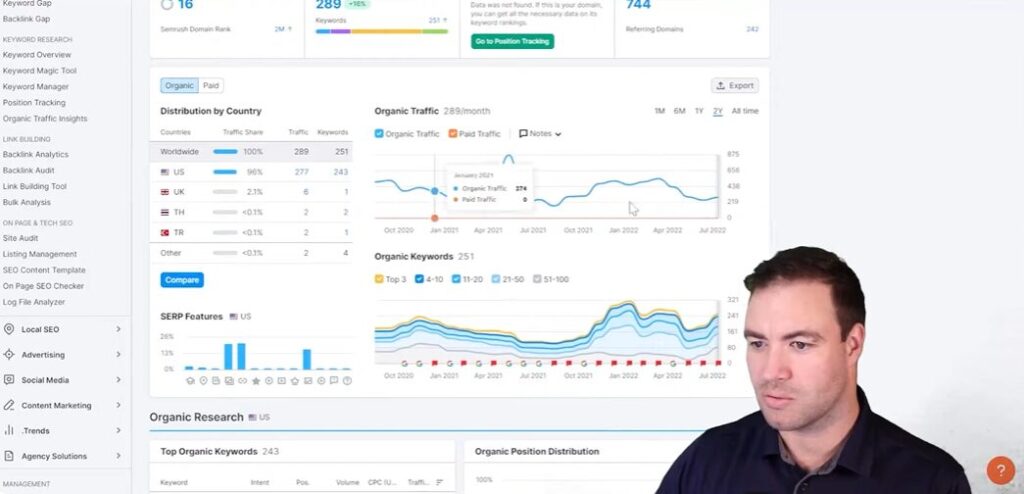
When I first started using SEMrush, I was amazed by its user-friendly site interface. It's designed for everyone - whether you're a newbie or a seasoned pro. Navigation is straightforward, with clear categories and options laid out. You’ll find everything - from keyword analysis, keyword research to competitive analysis - just clicks away with this helpful tool.
Each section has intuitive buttons and tabs. That makes it easy to jump from one feature to another without getting lost. I like to think of it as wandering through a well-organized library, where finding your favorite book is a breeze.
Let’s talk about the first step: inputting your domain. To get started, simply type your website’s address into the search bar at the top of the page. It’s like giving SEMrush the key to your digital house. The tool then fetches data about your site’s performance.
Next, you’ll want to analyze your competitors. For me, I always gather a list of competitors that are relevant to my niche. Avoid picking random websites; focus on those you truly compete with. After inputting their domains, SEMrush does its magic. You’ll get insights on keywords they rank for, their traffic, and more. It's like having a backstage pass to their success!
Once you've entered your domain and competitors, the dashboard is your command center. It presents crucial metrics at a glance. You’ll see graphs indicating traffic trends, organic keywords, and even a comparison with competitor domains. It feels empowering to visualize this data!
The dashboard layout organizes information clearly, which I found extremely helpful when examining complex data. Key metrics are often highlighted for quick reference. I often ask myself, "Which keywords can I target next?" and the dashboard guides me in the right direction.
Overall, SEMrush’s interface, coupled with its powerful analysis capabilities, is a game-changer. It provides a holistic view of my online presence, enabling informed decisions about my SEO strategy.
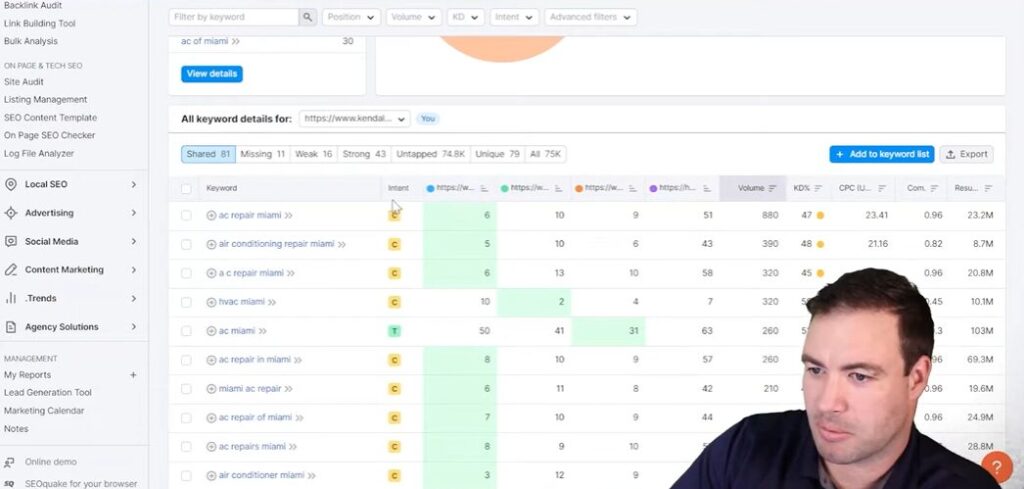
When it comes to understanding our position in the industry, selecting the right competitors for analysis is key. Who are the players in our market? Identifying these competitors helps us grasp where we stand. Here’s how we can efficiently conduct this analysis.
First, we need to pinpoint the major competitors in our industry. Start by searching for companies that offer similar products or services. These are not just any businesses; they should directly impact our target audience. Try asking yourself:
It can also help to consider indirect competitors. These are businesses that offer alternative solutions to the same problem our target customers face. By broadening our scope, we gain a more comprehensive view of the competitive landscape.
Next, we need to evaluate our selected competitors. Search for their root domains rather than just focusing on specific service pages. Here’s why:
After gathering competitor domains, we can use tools like SEMrush to analyze their performance metrics. This process reveals critical insights into their keyword strategies and weaknesses.
As we strategize, we can use a few tips to ensure we choose the right competitors:
In my experience, understanding what’s working for others helps adapt our own strategies effectively. This way, we can harness opportunities our competitors might be missing.
“Conducting competitor analysis is crucial for any successful SEO strategy.”
By following these steps - identifying key competitors, evaluating their domains, and applying these tips - we lay the groundwork for robust analysis. It’s all about becoming sharper in our approach and looking for ways to improve our own strategies.
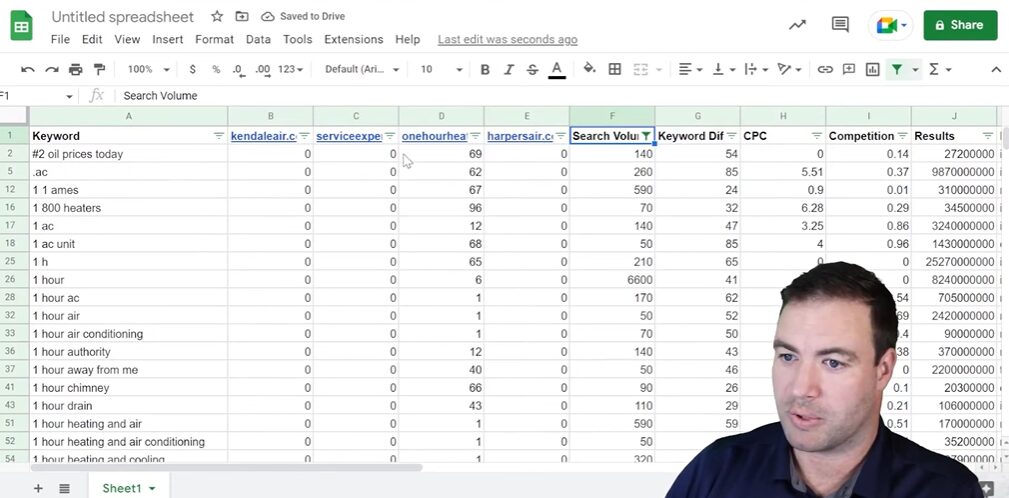
When we dive into competitor analysis, using tools like SEMrush becomes invaluable. Today, I'm going to share how to effectively conduct this analysis in a few simple steps.
The first step is to input your competitor's domain into SEMrush. It's easy, really. You just need to find those relevant competitors in your niche. For instance, if I'm analyzing an HVAC service in Miami, I might choose a contractor like "Kendall Air" as a stand-in example.
After entering their domain, SEMrush provides a wealth of data. You can check their performance metrics, such as the total number of keywords they rank for. Let’s say "Kendall Air" ranks for 251 keywords, but not much growth is seen. This is a critical insight!
Once you have entered the domain, you can utilize SEMrush's "keyword gap" feature. This feature compares your domain with those of your competitors. It's a checker that helps identify overperforming keywords - those that your competitors are ranking well for that you aren't.
Consider examining keyword intent, which is the reason behind a search term. By understanding the volume and difficulty of these keywords, we can gauge their potential impact. For instance, let's say “AC maintenance in Miami” ranks well for a competitor. It’s crucial to grasp why it performs well and how we can leverage that.
After analyzing the keyword overview, it's time to focus on the overperforming and underperforming keywords. Overperforming keywords are strong opportunities. They can help us gain visibility if targeted properly. Meanwhile, underperforming keywords indicate missed opportunities. Why aren’t they connecting with your audience? Maybe our content isn’t aligned with searcher intent.
When you export this data to Google Sheets, we can brainstorm content ideas tailored to our audience. Creating pieces like “Top Ten Reasons Why Your Air Conditioning Compressor is Not Turning On in Miami” can attract traffic and potential customers.
Remember, this is just one piece of the larger SEO puzzle. Always consider factors like backlink quality, too. So, next time you're diving into competitor analysis and research, keep these steps in mind! It might just give you the edge you’ve been looking for.
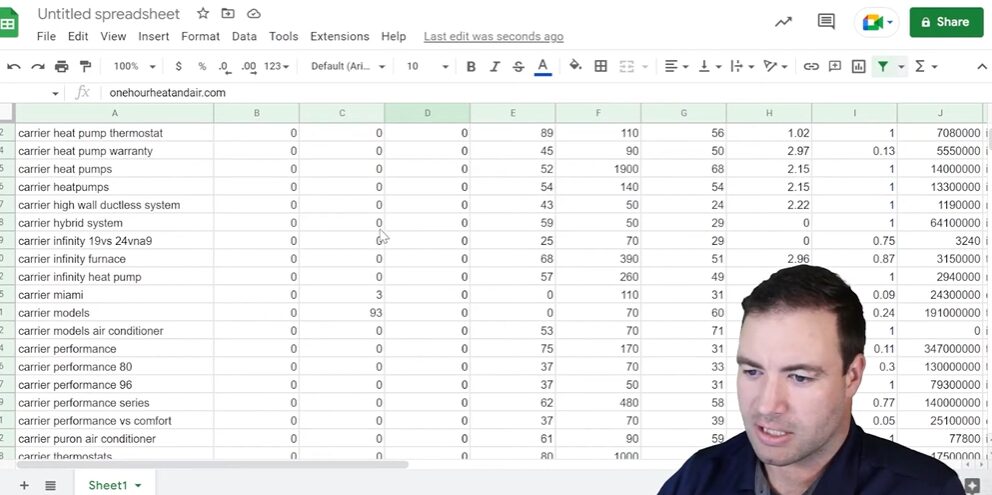
Understanding SEMrush data outputs isn't as challenging as it seems. I mean, we’re dealing with digital metrics that can feel overwhelming at first. But here's the thing: once you get the hang of it, it becomes second nature. Grab your competitor’s domain, plug it into SEMrush, and watch the magic happen.
You'll be presented with a layout that includes various metrics. For instance, you’ll see the total number of keywords your competitor ranks for, their estimated traffic, and even their domain authority. Think of this like peeking into a treasure chest of insights. Instead of gold doubloons, you're finding information that could elevate your strategy.
Let’s get to the heart of the matter: identifying keyword opportunities. Imagine you're looking over your neighbor's fence and noticing what they have that you don't. In this analogy, SEMrush acts as your trusty binoculars.
By doing this, you pinpoint potential keywords that could significantly benefit your strategy. For instance, if your competitor “Service Experts Miami” ranks well for "AC maintenance Miami," that’s a clear opportunity for you to explore.
Next on our list: understanding the link between keyword intent and search volume. It’s not just about finding keywords; it’s about knowing what users are looking for when they type them in. Think of this aspect as understanding your audience’s mood - are they just browsing, or are they ready to buy?
For example, a keyword like “HVAC service Miami” might have a low search volume of thirty, but the intent behind it could indicate a service seeker. Recognizing the intent allows us to tailor our content more precisely, appealing directly to the users who matter!
Additionally, filtering keywords based on search volume can uncover hidden gems. Keywords with more than fifty searches a month can lead to blog topics that attract valuable traffic. For example, articles like “Top Ten Reasons Why Your Air Conditioning Compressor is Not Turning On in Miami” can draw in those searching for answers.
So, remember, while conducting a keyword analysis, it's not just about pulling data; it's about making that data work for you. Understanding the nuances of keyword intent, paired with solid search volume metrics, is what transforms an average blog into a traffic magnet.

When creating content, choosing the right keywords is crucial. It's like having a map before a journey. A keyword gap analysis can unveil valuable insights. You see, we're not merely picking words; we're finding our audience's voice.
Start by assessing competitors. SEO tools are fantastic for this task. Enter a competitor's domain and see the keywords they rank for. Are those keywords relevant to your services? If yes, they may deserve a spot on your content list. I like starting with high-volume keywords, but don’t ignore the low-hanging fruit too. Sometimes a less popular keyword can attract niche audiences, which can be equally rewarding.
Content gap analysis is a strategic approach that aims to pinpoint the differences between the content currently available and what potential audiences are actually looking for, especially in terms of keyword gaps. By investigating the keywords that competitors rank for but your own content lacks, organizations can discover opportunities to develop targeted content that fills these voids. This method not only improves the relevance and visibility of the content but also aligns it more closely with user intent, ultimately leading to increased traffic and engagement. By systematically conducting content gap analysis, businesses can enhance their content strategies, ensuring they adapt to the changing needs of their audience while effectively competing in their markets. Add this to your usual SEO strategy and see that you'll increase in rankings.
Once we've gathered our keywords, the next step is alignment. Think of gaps as opportunities. What services are you not promoting enough? Are there keywords that directly relate to your business but aren’t in your current content?
A keyword gap analysis not only highlights what competitors do but also shows what you need to address. It’s about building bridges - connecting your services with what people are searching for.
Now, let’s talk timelines. SEO isn’t an overnight success story. You need to set realistic expectations. When implementing changes after your keyword analysis, consider the following:
This approach not only organizes your workflow but helps keep your team motivated. Remember, celebrating small victories can keep morale high too!
In a world where digital competition grows daily, having a structured action plan can significantly enhance your results. Using tools for keyword analysis, aligning with your services, and maintaining a clear timeline can make your SEO efforts more effective. Let’s embrace the journey and watch how our content evolves!

As I dive into this strategy, I often see individuals overlooking local SEO. This is a crucial mistake! For businesses that thrive on local clients, the focus should always be on geographic keywords. Why? Because these terms are valuable for capturing local traffic.
For instance, if you're an HVAC service in Miami, searching for broader keywords may not yield the desired results. Instead, local phrases like “AC repair in Miami” can be goldmines. So, before getting engrossed in national or global keywords, we need to start by pinpointing our local audience. A keyword analysis can help, but it needs to have a local lens. Have you considered how your competitors are using localized keywords effectively?
Another pitfall is falling for vanity metrics. These are numbers that look impressive but don’t help in driving actual results. For example, a high keyword ranking may look good on paper, but if it brings in little traffic, is it really worth celebrating?
When I analyze datasets from tools, I ask myself: “What’s the real impact of these rankings?” Often, the answers lie deeper.
Finally, let's address a critical aspect that sometimes gets lost in the excitement of keyword analysis: backlinks. In my experience, failing to analyze backlink data can be detrimental. Backlinks dictate how authoritative a website is and how well it can rank. So, even if you identify great keywords, without the right backlinks, those keywords might not boost your rankings as expected.
Remember, it’s about the whole picture. A successful SEO strategy involves a mix of keyword strategy, local search focus, and strong backlink building. I’ve seen this approach work wonders for my clients.
In conclusion, while keyword gap analysis can provide useful insights, it’s essential to avoid these common mistakes to unlock its full potential. Have you faced any of these challenges in your SEO journey?
As we wrap up our discussion, let's take a moment to recap the importance of keyword gap analysis. This tool is a game changer for anyone serious about improving their digital marketing strategy. It exposes the keywords your competitors are ranking for that you may not even be targeting. Think of it as a treasure map leading you to opportunities that can enhance your search engine visibility.
When I first began using SEMrush, I was amazed at the insights it provided. Keyword gap analysis isn't just about identifying what others are doing; it’s about understanding the landscape and finding your unique position within it. Once I dove into the data, it became clear that there were keywords my website could leverage to gain traction. And trust me, those insights were pivotal.
But don’t stop here! I encourage you to dive deeper into the features SEMrush offers. There's so much more than just keyword gap analysis. Experiment with various tools like content optimization and backlink analysis. Each feature equips you with vital information. This knowledge can fundamentally change your approach to SEO.
Lastly, I’d love to hear from you! What strategies have you found effective? Have you had your own experiences with keyword gap analysis? Sharing success stories not only inspires others but can also provide insights that lead to collective growth. If you have questions, don’t hesitate to reach out! We’re all on this journey together, and your input can help shape future discussions.
In conclusion, a keyword gap analysis can illuminate growth opportunities. By understanding where our competitors excel, we can make informed decisions about our SEO strategies. Remember, it’s not just about keywords, it's about crafting meaningful content that resonates with your audience. So let’s get to work and start capitalizing on those insights!
As someone who has navigated the competitive world of digital marketing, I've always believed that SEO is like landscaping itself - requires a solid foundation, a clear vision, and the right tools. This blog post isn't just for the pros; if you're a landscaper wondering how to grow your online presence, you're in the right place. I’m here to guide you through crucial strategies to make your business bloom, just like the beautifully tended gardens we all admire.
TL;DR: This guide provides landscaping businesses with effective landscaper SEO strategies, including a detailed checklist to improve their online visibility and rankings, particularly through Google Business Profile optimization and keyword research.
When it comes to growing a landscaping business, one term often stands out: SEO, or Search Engine Optimization. I firmly believe that good SEO is the backbone of online visibility. Without a solid SEO strategy, it's like having a beautiful garden hidden behind a tall fence. You can have the best services in the area, but if potential customers can't find you online, your efforts can go to waste. Let's dive into the essentials of SEO for landscaping businesses.
You've probably heard it before, but let me stress this: SEO is crucial. It's not just about cramming keywords into a webpage. It's about understanding how search engines work and how your customers search online. Think of SEO as a map that leads to your business. When done correctly, it guides potential customers right to your door.
To maximize organic searches, I always recommend starting with keyword research to discover what terms potential customers are using. It’s the difference between being invisible and being the go-to service for landscaping in your city.
Landscaping businesses have unique challenges when it comes to SEO. For starters, there's a lot of competition out there. It's not just other landscapers; home improvement companies and gardeners can cloud your visibility. Add to that the fact that many landscapers are locally focused, and the difficulty ramps up even more.
One of the significant hurdles is creating content that stands out. Most gardeners and landscapers rely on similar phrases and services, making it hard to differentiate. Imagine trying to sell a sunflower in a field of sunflowers. It’s crucial to find your unique selling points and integrate them into your content. We need to ask ourselves: What makes my service special? Why should someone choose me over a competitor?
Also, constantly updating website content can feel overwhelming. As a landscaper, you’re likely focused on projects - not on content creation. However, neglecting this aspect can lead to missed opportunities. Establishing a content calendar and including seasonal tips or project highlights in your blog can help keep your website fresh and engaging.
Local SEO is a game-changer for landscaping businesses. We aren't just casting a wide net; we want to catch the fish swimming closest to us! Optimizing your Google Business Profile (GBP) is crucial for attracting local clientele. With strong local SEO, your business can appear in first page results when someone nearby types “landscaper in [your city].”
Here are a few strategies that I recommend:
In summary, embracing local SEO strategies can significantly enhance your visibility and drive more local customers to your doorstep. It’s like planting seeds - nurturing them will yield the most beautiful results.
We all want our landscaping businesses to flourish. So let's optimize for search engines, tackle those unique challenges, and embrace the power of local SEO. Together, we can cultivate an online presence that draws customers in like bees to flowers!
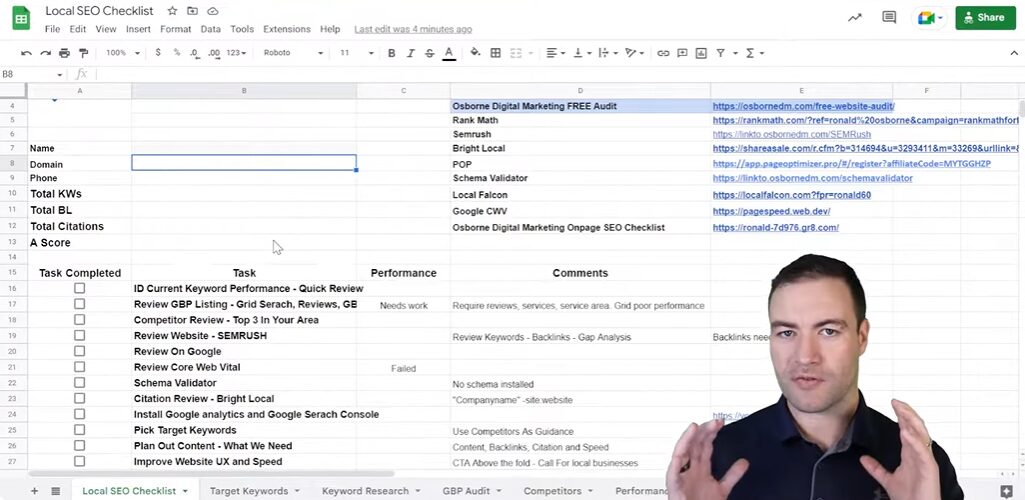
When it comes to Landscaper SEO, every business owner should have a clear plan. It’s not just about building a website; it’s about making that website work for you. Let’s break down the essential steps that can elevate your online presence and make your landscaping business shine.
First, what is SEO? SEO stands for Search Engine Optimization. It's the process of optimizing your online presence, so search engines like Google can find you easily. Think of your website as a garden. Without care and attention, it’s just land. With the right nurturing, it blossoms and attracts visitors.
So, where do we start? I like to think of SEO as a multi-step process - like planting a garden:
As we work through this, let’s talk about the tools that make all this tracking and analyzing achievable. I can’t emphasize enough how useful SEMrush is. With its powerful keyword research capabilities, it helps identify the best terms to target.
It’s like having a compass in a dense forest. It tells you where to go and helps you navigate through the jungle of information.
Now, let’s dive into backlinks. Why are they so crucial? Backlinks are links from other websites to yours. Think of them as votes of confidence. The more quality backlinks you have, the more authoritative your site appears to search engines.
Building a strong backlink profile is vital. High-authority sites linking to yours tells search engines that you can be trusted. You wouldn’t take advice from someone who hasn’t proven themselves, right? Neither would Google.
To build these links, consider:
Authority isn’t just about quantity; it’s about quality. A single link from a reputable site can be worth more than dozens from lesser-known sources.
Finally, we can’t forget that SEO isn’t a “set it and forget it” deal. It’s an ongoing process. You must continuously monitor your SEO performance metrics using tools like Google Analytics and Google Search Console.
Ask yourself: Are my rankings improving? Am I getting more clicks? What content resonates with my audience? If something isn’t working, don't hesitate to pivot. Just like a gardener adjusts as the seasons change, so must your SEO strategy.
By following these steps, utilizing essential tools, and focusing on building authority through backlinks, you’ll spark growth in your online landscaping business. When you make adjustments, don’t be afraid to seek out expert help. Sometimes, just a little guidance can make a world of difference.
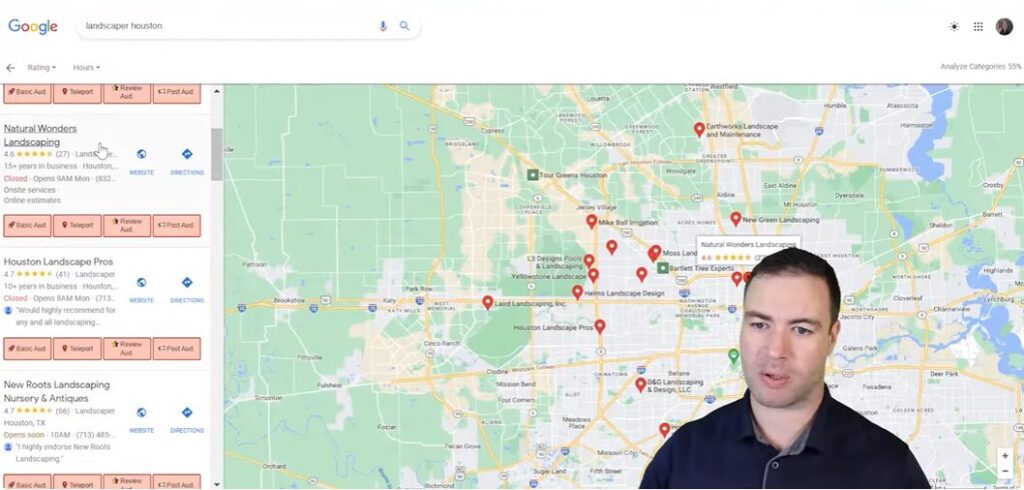
The Google Business Profile (GBP) is a powerful tool for any business aiming to improve its local SEO. It’s more than just a listing; it’s a platform that can significantly enhance visibility. But what exactly does it offer? Let’s delve into its core features, how to optimize your profile, and the significance of reviews and photos.
The Google Business Profile serves as your business's digital storefront. When potential customers search for services like yours, GBP is often the first thing they encounter. Here are some standout features:
Utilizing these features can truly make you stand out. Think of it as your online business card that you can update regularly.
Now that we understand what GBP can do for us, how do we make it shine? Here’s how we can optimize our profiles:
By taking these steps, we can significantly enhance our chances of being seen by potential customers. Imagine having a vibrant storefront that always showcases the best of what you offer.
So, why should we care about reviews and photos? Simply put, they are vital for building trust and attracting customers. According to studies, over 85% of consumers trust online reviews as much as personal recommendations. That’s huge! Here’s why they matter:
It’s a little like a friendly neighborhood store where everyone talks. Keep those interactions flowing! When you have happy customers posting reviews and sharing photos, it’s like word-of-mouth marketing, but on a much grander scale.
To wrap it up, the Google Business Profile is crucial for local SEO success. Whether you're a thriving local business or just starting, optimizing your profile effectively can lead to tremendous gains in visibility and customer trust. Remember, being present and active online is just as important as the exceptional service we offer.
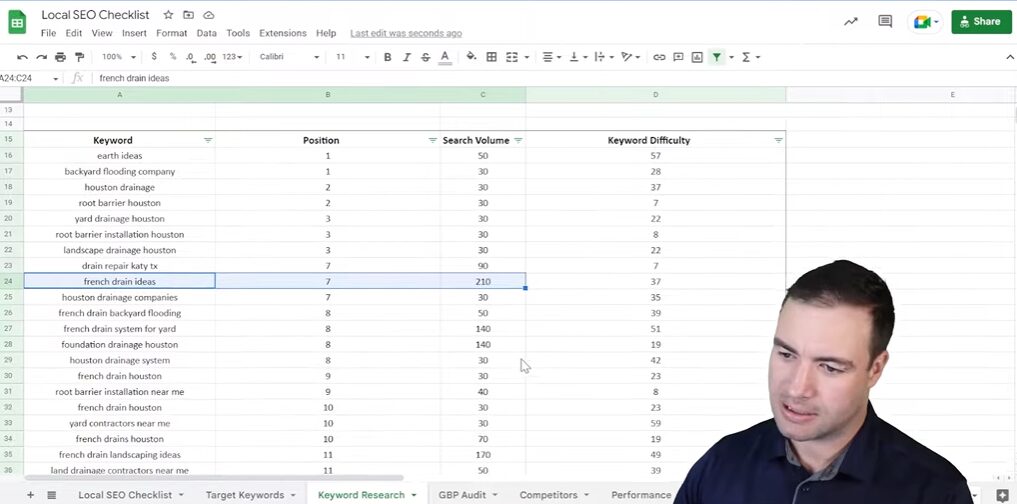
Keyword research is a foundational aspect of any successful SEO strategy. I can’t stress enough how vital it is to find the right keywords, especially when targeting local clients. So, how do we identify those keywords that resonate with our audience? Let’s break it down.
When I think about keyword research, I envision it as a treasure hunt. We're on a mission to discover the words potential clients are using to find services like ours. The first step? Understanding the audience.
Ask yourself: What does your ideal client search for when they need your services? Are they looking for “best landscaper in [your city]” or “affordable lawn care services nearby”? These phrases often contain locality that can lead you to highly relevant keywords.
Now that we’ve identified potential keywords, it's time to dig deeper using tools. I often lean on platforms like SEMrush or Google Keyword Planner. Here’s what I’ve learned:
These tools can be incredibly useful. You can often export data into spreadsheets, helping you map out a clear keyword strategy based on both opportunities and risks.
Once we have our selection of keywords, it’s time to create content. But here’s the kicker: simply sprinkling keywords into your text won’t cut it. We've got to align this content with what your audience is actually searching for.
Think about it - if someone searches for “best landscaping service in Houston,” and your blog only discusses general landscaping tips, there’s a disconnect. Our content must provide the answers they seek. Here’s how:
In my experience, it’s about being in tune with what your potential clients need. Optimize your content for user experience. This means incorporating images and easy navigation along with your targeted keywords. Audience engagement is vital!
Ultimately, keyword research isn’t just a checklist - it’s a strategy. It’s about understanding our local market and tailoring our SEO efforts accordingly. By following these approaches, we can significantly enhance our visibility in search engines and connect with the clients who truly need our services.
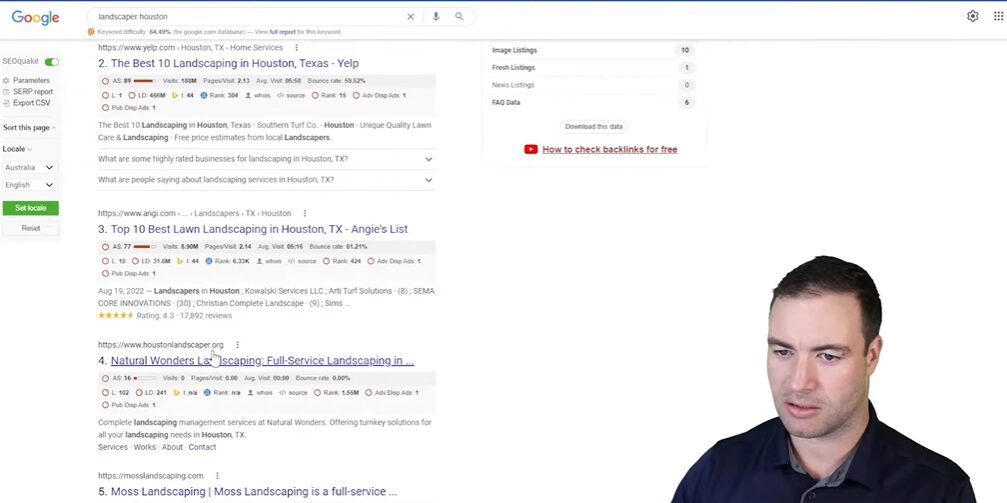
In the world of SEO, understanding what your competitors are doing is crucial. Why? Because if we don’t keep an eye on them, we risk falling behind. Competitor analysis isn’t just beneficial; it’s essential for anyone serious about enhancing their online presence.
When I first started in the SEO game, I was amazed at how much information is readily available just by looking at my competitors. Think about it: they’re targeting the same audience. They’re competing for the same keywords. If we analyze their strategies, we can also learn from their mistakes and successes. It’s like having a cheat sheet!
We can discover what works well and what doesn’t. This means identifying keywords that drive traffic, understanding their backlinks, and observing their content strategies. Competitor analysis arms us with insights to refine our strategies, making them more effective.
By gathering this information, we can position ourselves more strategically in the market. After all, knowledge is power, right?
I can’t stress enough the value of tools dedicated to competitor analysis. Some popular options include:
Using these tools can feel a bit overwhelming at first. But trust me, once you start digging into the data, it opens up an entirely new way of thinking about your SEO strategy. It’s like peeking behind the curtain!
Now, let’s talk about the metrics that are critical when you analyze competitors. It’s not just about having data; it’s about knowing which data is valuable.
Many people overlook backlinks, but they can significantly impact your domain authority. Monitor both the number and quality of competitor backlinks. Just having a lot isn't enough; we need the right connections.
Which keywords are they ranking for? Tools like SEMrush allow us to see this in detail. It’s essential to track how keywords perform over time and which generate organic traffic.
What topics resonate best with their audience? By examining the type of content they produce, we can find inspiration for our content creation.
Let’s not forget about social media. How often do they post? What type of posts get the most engagement? Understanding this can help us refine our social media strategies.
If your niche relies on local searches (like landscaping), check their Google Business Profile metrics. Look at ratings, reviews, and posting frequency.
“By analyzing our competitors, not only do we identify gaps in our own strategies, but we also pave the way for new opportunities.”
So next time you’re planning your SEO strategy, remember to do thorough competitor analysis. It’s more than just tracking them; it’s about learning and leveraging their strengths against your own.

When it comes to enhancing your Landscaper SEO strategy, the steps you take are crucial. I like to think of it as building a house. You wouldn’t start without a blueprint, right? Prioritizing changes based on their impact and effort is the first foundation we need. When we look at SEO efforts, understanding what brings the most value with the least amount of work can save time and resources.
Imagine you have a long list of tasks. Some are easy to execute, while others might take a lot of time and resources. So, how do we determine what to tackle first? Here, the impact-effort matrix can be your best friend. This matrix is a simple way to visualize which changes could yield the greatest results for your SEO efforts.
This kind of prioritization helps streamline your efforts. It provides clarity about where to focus your resources for the best ROI. I always say, “Work smarter, not harder.”
Once we know what to prioritize, the next step is developing a detailed action plan. Think of it as your roadmap for SEO success. An efficient action plan includes:
Last month, I worked with a landscaping business to enhance their online presence. Together, we created a specific action plan that outlined our approach clearly. Having that road map made a world of difference, guiding us through each step of the process.
Implementing changes is only part of the journey; you can’t just set it and forget it. We need to circle back and analyze whether our efforts are paying off. Here’s how I recommend doing this:
As I always remind my clients, “If you can’t measure it, you can’t manage it.” Regular reviews allow us to adapt and improve over time. SEO is not a one-time thing; it's an ongoing journey. Let’s be proactive, not reactive.
In essence, implementing changes requires a systematic approach. By prioritizing actions based on impact, creating a solid action plan, and regularly reviewing our strategies, we set ourselves up for success. Remember, the journey of a thousand miles begins with a single step. What’s your first step today?
As I look back on our journey through the intricacies of SEO for landscaping, I can’t help but feel a sense of accomplishment. We have explored a range of strategies aimed at enhancing the online presence of landscaping businesses. Each step has been about nurturing our SEO garden, allowing it to grow and flourish in a competitive market. Just like a garden, SEO takes time, patience, and continuous care.
When I first started discussing SEO for landscapers, I was eager to showcase practical tools and strategies. The landscaper SEO checklist was designed not just to tick boxes but to serve as a roadmap for anyone, whether you are running a small local business or managing SEO for multiple companies. Through using tools like SEMrush and conducting competitive analysis, we've discovered how crucial it is to not only understand where you currently stand but to envision where you want to go.
As we step into the future, it's essential to keep an eye on emerging trends impacting SEO. The world of technology evolves rapidly, and staying updated can give you a competitive edge. Here are a couple of trends that I believe are vital to watch:
Recognizing these trends will help us maintain our SEO gardens beautifully, ensuring they remain vibrant in a rapidly changing landscape.
I want to close this section with a thought that resonates with me: the journey of learning never ends. SEO is not a set-it-and-forget-it endeavor. It's about continuously adapting and evolving. When we consider the meticulous work that goes into each step - conducting keyword research, performing audits, monitoring performance analytics - it becomes clear that we must be committed to constant growth.
Think about it this way: Just as a gardener must adapt to the seasons and changing conditions, we must respond to shifts in search algorithms and market demands. Are you ready to keep nurturing your garden? As I wrap up this discussion, I encourage you to stay curious, experiment with new ideas, and never hesitate to reach out for help.
The landscape is competitive, but with the right tools and a steadfast mindset, we can cultivate spaces that not only attract attention but also yield fruitful results. I hope that together we can watch our SEO gardens flourish in the months and years ahead.
“Gardening teaches us that change is vital for growth.”
Remember, every little effort counts. Let’s keep learning, adapting, and growing together in the beautiful world of SEO for landscaping!
When I first ventured into the world of digital marketing, I felt like a kid in a candy store - excited but utterly clueless. I remember the sinking feeling of hiring an agency that promised the moon but delivered little more than crickets. That's why I’m here to share the lessons I’ve learned on how to discern the shining gems from the deceptive stones in this bustling marketplace.
TL;DR: Navigating the landscape of digital marketing agencies can be daunting. From assessing performance reports to understanding SEO timelines, this guide offers crucial insights on how to hire a digital marketing agency can help you make the right SEO strategy for your business.
When I first started exploring the world of digital marketing, I had no idea just how multifaceted a digital marketing agency could be. The services they offer are extensive and tailored to meet diverse business needs. Let’s dive into the key offerings that you can expect from these agencies.
The primary goal of hiring an agency is straightforward: to increase leads and ultimately boost your business revenue. Isn't that what we all want? If your marketing isn’t driving results, you’re just spinning your wheels.
Now, let’s talk about another essential aspect: credibility. For local businesses, building a trustworthy image is crucial. A solid digital marketing agency can help enhance that credibility. They should have a track record of driving results for similar businesses. After all, if a potential client sees positive reviews and tangible successes, they’re more likely to choose you over a competitor.
It’s important to remember that not all agencies are created equal. They vary widely in their levels of service and expertise. Some may promise the world but fail to deliver. That's why I always recommend vetting potential agencies thoroughly. Ask for evidence of past successes. If they can't provide real results or specific metrics, it’s a red flag.
In my experience, choosing the right agency isn't just about picking the cheapest option. Digital marketing is an investment. And like any investment, you want to ensure you're getting value in return.
As I continue on this journey of learning about digital marketing, I find it fascinating how many elements come into play and how they intertwine to create a comprehensive strategy. From knowing the services offered to evaluating the credibility and expertise of agencies, each step is crucial in crafting a successful digital presence.

When it comes to hiring a digital marketing agency, there’s no room for guesswork. I’ve learned the hard way that the wrong choice can cost you time and money. So, how do you vet potential agencies effectively? Here’s what I discovered through my conversations and research.
First off, don't just take an agency's word for it. I always ask for testimonials and success stories that include tangible numbers. What does this mean?
If an agency can’t provide specifics or only shares vague success metrics, that should set off alarm bells. Why withhold such crucial information?
Another critical step is to ask for monthly performance reports. A reputable agency will have no problem providing these. Reports should show clear evidence of progress. They should cover key performance indicators (KPIs) relevant to the services you’re using. Depending on the scope, this might include:
In my experience, if a digital marketing agency doesn’t deliver these reports after the first month, that’s a major red flag. Regular documentation not only keeps me informed but also shows the agency is genuinely invested in my success.
Remember, understanding the metrics is key. Digital marketing is a marathon, not a sprint. If an agency is putting pressure on you for quick results or bottom-line success without documentation, it's best to steer clear. They might not be the right fit for your needs.
It’s all about finding the right partner who shows tangible results through meaningful metrics. That way, I can be confident my investment is working for me.

When I first entered into the world of SEO, I had a certain idea in mind. I thought it would be a quick fix. But soon, I learned one crucial lesson: SEO is a marathon, not a sprint.
In most cases, don't expect to see noticeable changes in just days or weeks. Instead, I learned that real progress can take anywhere from 6 to 12 months. Think about it like planting a tree. You can't rush its growth. You water it, nurture it, and over time, it flourishes. This long timeline helps set a strong foundation for your website's rankings to improve.
Many agencies market themselves by promising quick results. Let's be honest, who doesn't want to rank high on Google tomorrow? However, I realized that if someone guarantees immediate results, it's a huge red flag. They might be using tactics that can increase visibility, but not sustain it. It's like eating junk food. You feel good for a minute, but the crash follows soon after.
Another aspect to think about is the competitive landscape of your industry. Some niches are more crowded than others. If I'm in a highly competitive field, I have to work even harder to rank. It’s essential to do research on competitors. What strategies are they using? What keywords are they targeting? This understanding helps in crafting a smart SEO strategy.
Different SEO services come with different timelines. For instance, local businesses might see faster results compared to e-commerce giants. There are so many variables at play! This makes it crucial to define which services I really need and what expectations I have for them. It’s about aligning these timelines with my specific goals. If I’m launching a new product, will I need immediate visibility? Or can I focus on building my online presence gradually?
In the end, setting realistic expectations for SEO is vital. Recognizing this journey and being patient can lead to more fulfilling outcomes in the long run. After all, what’s the rush? Good things take time, and the results will be worth the wait. If you’re diving into SEO, remember, this isn’t a race; it’s all about the steady progress we make along the way.

Going though the process on how to hire a digital marketing agency can be tricky. Trust me, I've been there. It's easy to overlook some crucial details in the excitement of improving your business's online presence. Here’s what I’ve learned about identifying red flags in potential agencies:
One of the first things I do is check how well the agency ranks for its own services. If they're not appearing on the first page of Google search results, what does that say about their ability to help me? They might not have the right skills to boost my visibility. After all, if they can't attract leads for themselves, will they be able to do it for me?
Next, I dive into their customer service. Can I get in touch easily? Will they respond promptly when I have questions? Communication is key. If I see signs of poor customer service in the early stages, I worry it might continue after making a commitment. I ask questions like:
This is a big one. I’ve encountered agencies that push hard for the sale, almost as if they are not interested in my actual needs. It feels like they’re reading from a script, eager to close the deal without fully understanding my situation. I need someone who thinks critically about my business. Rushing me into a decision raises a red flag. They should offer insights on whether digital marketing is truly a fit for my goals.
It’s essential to remember that not every business model benefits from SEO or social media marketing. For instance, a niche market might thrive through different channels. I’ve learned it pays to ask questions and gauge their understanding of my unique business.
In conclusion, my journey to hiring the right agency has taught me to remain vigilant. By focusing on these key red flags, I’m not only protecting my investment but also putting my business in a position to succeed.

When it comes to hiring a digital marketing agency, the importance of personal connection and support can't be overstated. The digital landscape is complex, and navigating it can feel overwhelming. That's why I believe finding the right agency means considering a few key factors that reflect understanding and assistance.
First and foremost, a great agency understands your business's unique needs. Every business has its own goals, challenges, and target audiences. An agency that recognizes this will tailor its strategies specifically for you. Think about it: Would you go to a doctor who treats everyone the same? Of course not! Likewise, I suggest that you find an agency that takes the time to understand your situation and creates a custom plan.
Another crucial aspect is communication. You want a partner who is just a phone call away. There have been times when I felt lost amidst marketing jargon, and having someone to call made all the difference. If your agency is responsive, it shows that they genuinely care. However, if you find yourself always playing phone tag, maybe it's time to reconsider. The presence of clear communication can foster trust and lead to genuine collaboration.
From my experience, genuine interaction is pivotal. I’ve spoken to hundreds of business owners who felt like they were just numbers to their agencies. They were frustrated and felt neglected. Remember this: you deserve more than just one-way communication. Your agency should seek to engage with you, not just during meetings, but also through consistent check-ins. This support can help you feel more confident in your marketing journey.
It’s essential to recognize these points when selecting a digital marketing agency. After all, your business is much more than a project for them; it’s your passion and livelihood. Let's strive to find partners who will help us grow and succeed personally and professionally.
As we wrap up our exploration on how to hire a digital marketing agency, I want to emphasize the essential points we've covered. My journey into this realm has revealed that choosing the right agency isn't just about shiny websites or impressive portfolios. It’s about understanding the nuances of their services and finding the right fit for my specific needs.
First and foremost, I've learned that digital marketing agencies offer a range of services, including SEO, Google Ads, and social media marketing. However, what truly matters is their track record. Evidence of success is crucial - genuine reviews and measurable outcomes should be prioritized over mere promises. If an agency can't provide specific results, I need to tread carefully.
Additionally, consistent and transparent reporting is key. Receiving regular performance updates should be the norm, not the exception. It’s a red flag if I don’t see updates after a month. Understanding the financial expectations is also necessary. As mentioned, realistic budgets for quality services are essential. If an agency offers services that seem too cheap, the quality likely reflects that price point. A competitive SEO package would rarely come in under $650 unless red flags wave profusely.
Now, let me provide you with a handy checklist for when you conduct your interviews:
Ultimately, the right agency will prioritize a productive partnership over a one-time sale. They should be willing to engage and support me through the ups and downs of the digital landscape. This reflection has been incredibly valuable, and I hope it's equipped you with the insights you need to navigate this journey. Remember, investing in digital marketing is a commitment - one that can pay off handsomely if approached wisely.
The complexities of hiring a digital marketing agency may seem daunting, but I feel more prepared now. It’s about making an informed choice and finding a team that genuinely understands my business needs. If I need assistance, Osborne Digital Marketing, as suggested by Ron, could provide the right guidance. Don’t hesitate to reach out - let’s make those digital marketing dreams a reality together.
When I first dipped my toes into the world of digital marketing, I was bewildered by Google Search Console. One day, an old friend of mine asked me about getting his charity website, focused on asbestos awareness, to rank better. It turned out, the secret was as simple as adding a sitemap. Through a few lightbulb moments, I learned how crucial this step is and now, I'm excited to share my journey and tips on how to do it yourself!
TL;DR: Learn how to add a sitemap to Google Search Console to improve your website's searchability and make it easier for Google to crawl your site.
Have you ever thought about how search engines like Google find your website? It’s not magic; it’s all about organization. This is where a sitemap comes in. I truly believe that sitemaps are critical for guiding search engines straight to your content.
Sitemaps are essential tools. They serve as a guide for search engines to understand the layout of your website. Here’s a simple way to look at it: imagine you’re exploring a new city. Would you prefer to wander aimlessly, or would you rather have a map? Of course, a map helps!
When I was setting up my website, I quickly realized that creating a sitemap was a no-brainer. Here's why:
If you’re using platforms like WordPress, creating a sitemap can be straightforward. You can typically access it by typing sitemap.xml directly into your browser. That’s your first step! If that doesn’t work, look for sitemap_index.xml. It’s like trying different keys until one opens the door!
“A well-structured sitemap is the foundation of a successful SEO strategy.”
In my experience, taking time to set up a sitemap pays off. You’re not just creating an ordinary page; you’re building a pathway for Google. And, who wouldn’t want to take the scenic route when exploring their site’s potential?

Locating your sitemap can feel a bit daunting at first, but I promise it’s simpler than you might think. It's essential for keeping your website discoverable. Let me walk you through the steps.
First things first - what platform is your website built on? Knowing this will guide you in finding your sitemap. Common platforms include:
Each platform may have different processes for sitemap creation, so it’s worth taking a moment to identify yours. For example, if you’re using WordPress, you’ll have a couple of straightforward options.
Next, let’s move into the URL formats. A typical sitemap can usually be found at:
sitemap.xmlsitemap_index.xmlWhat’s more, some platforms will automatically generate these files for you. So, just by typing one of these URLs into your browser, you might just strike gold! If you don't see anything with sitemap.xml, try sitemap_index.xml instead. Don’t be surprised if you're redirected here if you have certain plugins installed (like Rank Math, for instance).
Speaking of plugins, let’s talk about their importance in sitemap generation. For platforms like WordPress, having the right plugins can simplify the process immensely. They can automatically update your sitemap whenever you create or delete pages. This means less hassle for you.
Have you ever thought about how much easier website management would be if everything could be automated? With plugins, that’s pretty much what happens: installation leads to automatic sitemap generation!
So take advantage of these tools to ensure your website is as streamlined as possible. It’s like having a personal assistant who takes care of the technical mess.
By following these steps and checking each point, you can locate your sitemap with ease. Remember, finding it is just the first step toward making your website more visible to search engines. Happy hunting!
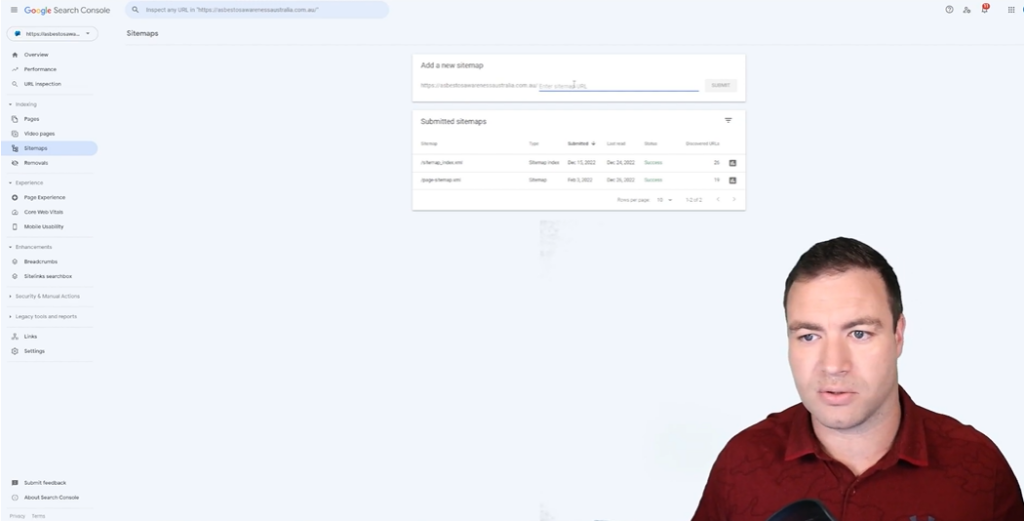
Let’s get into the nitty-gritty of uploading your sitemap to Google Search Console. Why bother with a sitemap? Simply put, it’s like giving Google a map to your content. If you're ready, let’s explore more on how to add a sitemap to Google Search Console.
First off, if you haven't logged in yet, head over to www.google.com/webmasters/tools/ and sign in with your Google account. Got it? Great! If you don't have an account, create one. It’ll only take a minute.
Once you’re in, you might see a dashboard showing your site's performance. If you have multiple properties listed, make sure you choose the right one - the one you want to submit the sitemap for.
This part is straightforward. In the left sidebar of Google Search Console, look for the “Sitemaps” option. It should be right under “Index.” Click on it.
www.yourwebsite.com/sitemap.xml or www.yourwebsite.com/sitemap_index.xml.Now, just hit the “Submit” button. That’s it! Your next step is waiting. It usually doesn’t take long for Google's crawlers to start indexing your site.
Sometimes things don’t go as planned. Here are a few common issues:
Don’t worry too much! This is just a learning curve, right? If you're still stuck, seeking help in forums or Google’s own help resources can shed some light.
So there you are! Navigating the process of uploading a sitemap doesn’t have to be overwhelming. Just think of it as providing Google with a guided tour of your website. Happy submitting!

When it comes to blogging, visibility is key. But, how do we ensure that our blog posts are easily discovered? One of the best strategies I've found is creating a specific sitemap for blog posts. It may sound technical, but it’s really quite straightforward.
A sitemap functions like a roadmap for Google, helping it navigate your website. Without it, your blog posts might remain hidden, making it difficult for your target audience to find them. I often say, “If you build it but no one knows, did it even exist?”
By organizing your content in this manner, you not only enhance visibility but also improve your site’s overall SEO. Think of it as setting up little signposts leading readers to your content.
Now, let’s talk about sub-sitemaps. What’s the advantage? By having separate sitemaps for different content sections, you give search engines a clearer picture of what to expect. This segmentation allows for more efficient indexing.
Imagine if you had to read a massive book without chapters. Confusing, right? Sub-sitemaps make it easier for both Google and your audience to digest the “chapters” of your blog.
Let me share how I put this into practice for a charity’s blog - Asbestos Awareness Australia. After analyzing their website structure, I noticed an opportunity for improvement. I created a sitemap specific for their blog posts, using a dedicated sitemap.xml file, which included links for each post.
Once that was sorted, I submitted the sitemap to Google Search Console. This simple act ensured that every single blog post was acknowledged and indexed. In the long run, it boosted their visibility and allowed more people to discover their vital content.
I encourage you to consider implementing sub-sitemaps for your own blog. You’ll be surprised at how much of a difference it makes!
As we wrap up our journey into enhancing your website’s visibility, let’s revisit the critical steps on how to add a sitemap to Google Search Console. Why, you ask? Well, a sitemap is like a treasure map for Google, guiding the search engine through the labyrinth of your content. It helps ensure that all your site's pages are indexed effectively, improving your chances of showing up in search results.
First, we discovered how to find your sitemap. For many, it’s as simple as typing "sitemap.xml" or "sitemap_index.xml" into your browser. Then, armed with that URL, we moved on to Google Search Console. Here, I demonstrated how to add the sitemap by navigating to the "Sitemaps" section and pasting in the link. Simple, right? This process lets Google know where to find the essential pages of your site.
But it doesn’t stop there. It’s vital to monitor Google Search Console for any updates or errors related to your sitemap. This might seem tedious, but maintaining this oversight can save you from potential pitfalls down the line. Imagine submitting a sitemap and finding out later that it had errors. Ouch! Regular checks can help you stay one step ahead.
Reflecting on my journey, adding a sitemap transformed my approach to SEO. It felt like unlocking a different level in a game, where suddenly, my website became more visible and engaging for users. I realized how influential a well-structured site can be. Remember, every small step matters in the quest for better online visibility. Your effort in ensuring your content is indexed properly will yield fruit in the form of increased traffic.
So, let’s not underestimate the power of that little sitemap. It’s a gateway to greater visibility. I encourage you to take these steps and start monitoring your site's performance. I’m excited to see where your efforts lead! Now, go out there and make your presence known!
Have you ever found yourself digging through your website, trying to find that one elusive page? I’ve been there too, and that’s when I realized the importance of having a well-structured HTML sitemap. This guide draws from my experiences in digital marketing, showcasing how you can create a customized sitemap that not only aids navigation but also helps you create an effective SEO strategy.
TL;DR: Creating a custom HTML sitemap can significantly enhance your website's user navigation and SEO. Here’s how to create an HTML sitemap without plugins, using Rank Math as a guide.
Let’s go straight into the why behind an HTML sitemap. Many bloggers and webmasters often overlook it, but understanding the purpose of a sitemap can significantly enhance not just the navigation of your site but also its visibility on search engines.
In simple terms, an HTML sitemap is like a roadmap for your website. Imagine driving through unfamiliar territory without a map. Confusing, right? A sitemap ensures visitors can find their way effortlessly, guiding them through your site’s structure.
Think of it this way: if your site has numerous pages, how will users remember where to click? An HTML sitemap lists all your pages, making it easier for visitors to pinpoint exactly what they're looking for. It’s all about user experience.
With an HTML sitemap, we enhance user navigation significantly. How? By providing a consolidated view of all your content in one accessible location. This feature is especially crucial for larger sites with multiple categories and subcategories.
Wouldn’t you want your visitors to spend more time on your site? An organized sitemap can help turn casual visitors into loyal readers.
Moreover, having an HTML sitemap can boost your site’s SEO visibility. Search engines like Google use sitemaps to understand the structure of your site better. When they crawl your site, having a clear map can lead to better indexing of your pages.
"A well-structured sitemap provides a clear insight into your content for search engines."
By enhancing the presence of your pages in search results, you could potentially increase your organic traffic. More visibility means more visitors. It’s that simple.
Lastly, let’s talk about the tools available to create a sitemap easily. While I often use Rank Math for its user-friendly features, there are alternatives for various needs:
Each of these tools has its benefits depending on your site's size and your level of expertise. I often recommend starting with something straightforward and upgrading to more advanced options as your site grows.
The important thing is to not overlook the value that an HTML sitemap brings. Whether through improved navigation, enhanced SEO, or the use of effective tools, creating one can genuinely transform the user experience on your site.
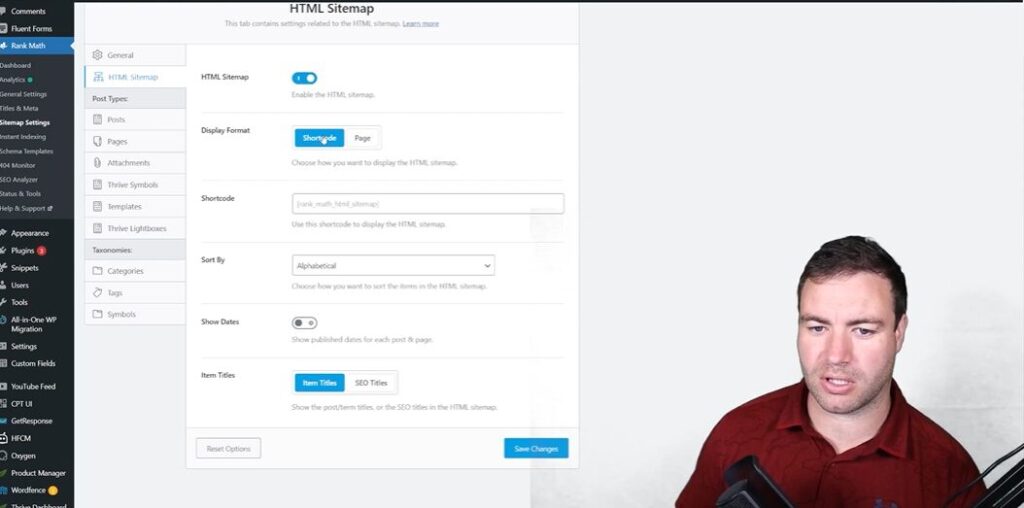
Rank Math is a powerful SEO plugin for WordPress. It helps you optimize your site effortlessly. One of its standout features is the intuitive interface that makes SEO settings approachable for all users. Whether you’re a novice or a seasoned pro, Rank Math’s interface offers ease of use.
Some key features include:
The free version of Rank Math offers robust features. I found it particularly handy for basic SEO tasks. But like anything else, it has its downsides.
Now, let’s talk about upgrading. When do you really need to consider the paid version? If your site is growing and you need more advanced features, it might be time to invest.
I personally upgraded for one main reason - time efficiency. The paid version simplifies complex SEO tasks. It’s priced at $60 per year, which is quite reasonable given the benefits. If you find yourself struggling with the complexities of SEO, the paid version opens up a whole new world.
I’ve used both the free and the paid versions of Rank Math. Initially, the free version served me well. However, managing SEO for my business coaching site became overwhelming. When I switched to the paid version, it felt like obtaining a Swiss Army knife for SEO! Everything was more streamlined.
For my charitable project, I opted for the free version. This decision was born out of necessity - not wanting to incur additional costs. I managed to make it work but at a fraction of the efficiency I got from the paid version.
Ultimately, I’ve learned that the right choice depends on your needs and goals. It’s all about finding the balance that works best for your project.
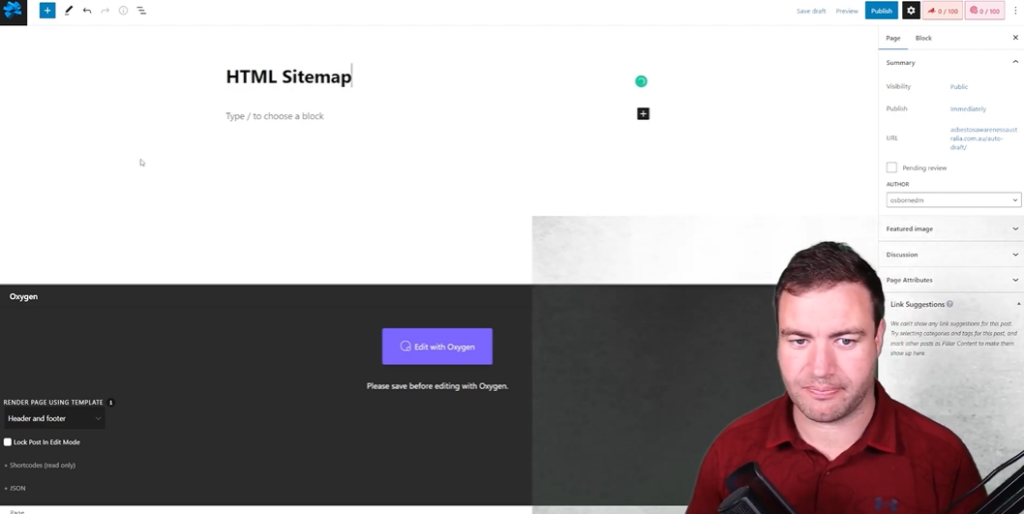
First things first, we need to get to the WordPress dashboard. This is the control center of your website. Just head to yourdomain.com/wp-admin and log in. It’s like opening the door to your office. Once you're in, you’ll see a menu on the left side. This is where all the magic happens!
Next up, let’s create a page for our sitemap. Click on Pages, then select Add New. Now you have a blank slate. Think of it as an empty canvas! Make sure to title it something clear, like HTML Sitemap, so visitors know exactly what to expect.
Don’t forget to publish it! It’s like sealing your artwork in a nice frame. Once that’s done, it’s time to dig deeper into the customization.
Now, let’s talk about shortcodes. If you’re using a plugin like Rank Math, you’ll need this magic code to display your sitemap. First, you have to locate the shortcode in the plugin settings. Once you find it, copy it, then head back to your new page. Paste the shortcode into the editor and save your changes.
Shortcodes are powerful! They’re like shortcuts that enable functionalities without much hassle. But if you’re not using a plugin, we’ll add elements manually. This adds a personal touch to your sitemap.
While creating your sitemap, I recommend having a focused approach. Here are a few tips I’ve picked up:
Creating a sitemap doesn’t have to be a chore. It can be a fun project that significantly improves your site’s usability. Think of it as laying down a clear path for visitors, guiding them through your website.
And remember, take breaks if you're feeling overwhelmed. It's just a sitemap - you're not building a rocket here!
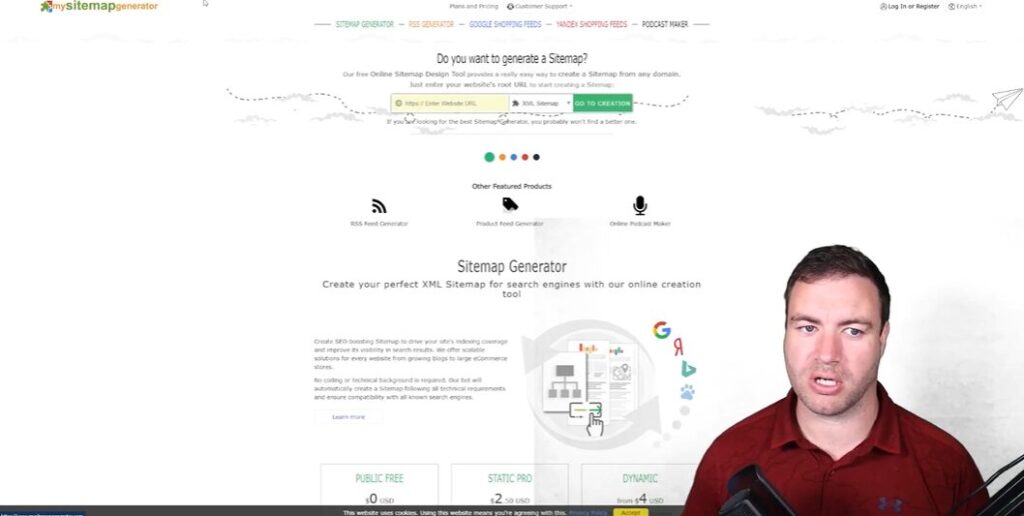
When it comes to learning how to create an HTML sitemap, we often think it’s just another checklist item. But what if I told you it could be so much more? Customizing your sitemap doesn’t merely enhance its aesthetics; it greatly boosts functionality as well. Imagine opening a webpage and finding a neatly organized list of resources, all tailored to your needs. Let’s explore into how we can achieve that.
Think about your sitemap as the map to a treasure trove of information. If it looks boring, will anyone want to explore? We can change that. A visually appealing sitemap captures attention and invites users to navigate. Use different fonts, colors, and formats to draw the eye. A well-organized layout will make it easy for users to find the information they want. Are you with me?
Incorporating images and videos can transform your sitemap. For instance, a brief video tutorial can guide users on how to use the site effectively. Or a compelling image can summarize a page’s content. Visuals make your sitemap dynamic and engaging!
As we curate our sitemap, it’s vital that we link important resources. Every link should lead to valuable content. I recommend that we prioritize links that get high traffic or have the most relevance to our audience. Think of it this way: each link is a door to a room filled with information. Would you want to lead people to a locked door? Absolutely not!
User engagement is key in keeping visitors on our site longer. How can we do that? Consider these strategies:
When users feel involved, they’re likely to linger. And that’s what we want, right?
In summary, customizing your sitemap can create a more engaging, functional, and aesthetically pleasing experience for your visitors. By enhancing its design, integrating rich media, linking crucial resources, and employing effective engagement strategies, we can transform what was once a mundane task into a valuable tool for our audience.
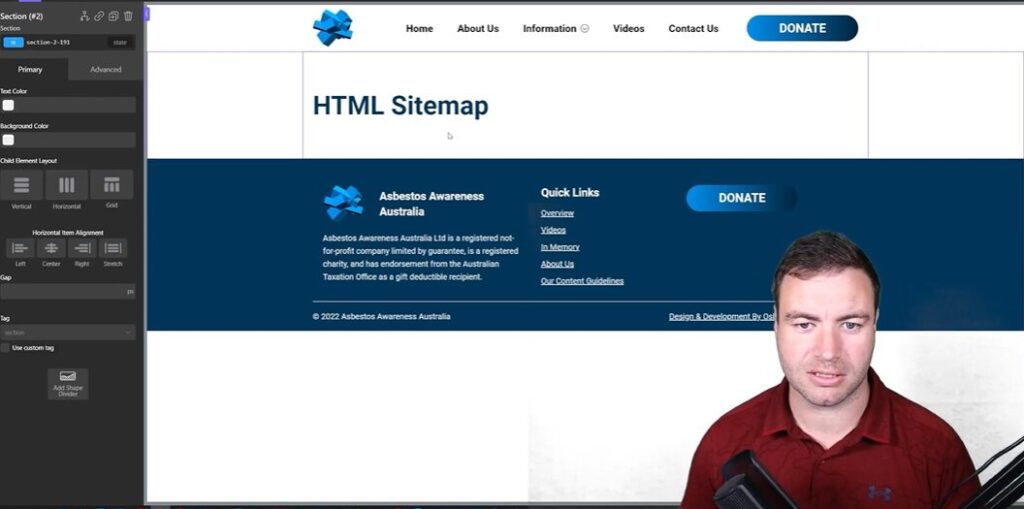
Creating a unique HTML sitemap may sound like a tedious task, but it’s a crucial part of web design. I can’t stress enough how beneficial it is for your site's navigation and SEO. Let’s delve into the basics of how to design a sitemap that stands out.
Have you ever landed on a website and struggled to find the information you need? Frustrating, right? An HTML sitemap helps to avoid this issue. It lists all the pages in a clear format, allowing visitors to navigate easily. Plus, search engines love it! They utilize the sitemap to better understand your site structure, which can enhance your SEO ranking.
I’ve used both automated and custom methods. While Rank Math provides a quick solution, a custom sitemap offers flexibility. You can adjust the design to better fit your website’s branding. This uniqueness is what makes visitors feel at home.
When it comes to building a custom HTML sitemap, there are a few key points to consider. First, we’ve learned that a sitemap isn’t just a list of links; it’s a powerful tool for improving user navigation. By creating a well-structured sitemap, we not only enhance the user experience but also boost our SEO efforts.
Remember, simplicity is key. A clean and intuitive design helps visitors find what they are looking for without frustration. Plus, organizing content by categories provides clarity and a faster way to access information.
We all face the dilemma of time versus money. In my experience, investing in a tool like Rank Math can save a lot of time - especially for larger websites. The annual fee of $60 can seem steep, but it might be worth it if you're short on time.
It’s all about what fits your needs best. Which outweighs the other for you?
We want our websites to grow with us, right? A custom HTML sitemap gives us the flexibility to adapt as we add more content. A well-planned sitemap can seamlessly integrate new pages and categories as they come.
Think of your sitemap like the blueprint of a house. The better it's planned, the easier it is to add new rooms later on. A well-structured sitemap lays a foundation for future growth without the hassle of starting from scratch.
Don’t forget about the human aspect of your sitemap! Engage with your audience when you launch your sitemap. Share informative posts or even create tutorials on how to make the most of it. This can spark interest and encourage users to explore your content further.
Remember to ask for feedback. “What do you think about our new sitemap?” This kind of engagement can help you refine your approach and serve your audience better.
After all, creating a custom HTML sitemap is not just about functionality; it’s about cultivating a relationship with your users. Are they finding what they need?
Learning how to create an HTML sitemap is about more than just linking pages. It’s about creating navigation that enhances user experience while also catering to SEO needs. Whether you opt for a quick method with Rank Math or dive deep into creating a custom design, the key is to prioritize clarity and simplicity.
I hope this breakdown brings clarity to your sitemap creation journey. It's a rewarding task that can significantly improve how visitors interact with your site. Cheers to a well-structured HTML sitemap that reflects your site’s uniqueness.
Hey there! I remember when I first started in the world of digital marketing. I was overwhelmed by the sheer volume of information available, especially regarding SEO. One night, after a long day, I stumbled upon a competitor's web traffic data. It was a game changer! Learning how to check competitor traffic not only streamlined my approach but also opened my eyes to opportunities I never considered before.
TL;DR: Understanding competitor website traffic is crucial if you are looking to improve your SEO strategies; here’s how to check a competitors website traffic using various tools.
When I first started diving into the world of digital marketing, I quickly realized one thing: keeping an eye on your competition is crucial. Why? Because they often hold the keys to success. Understanding how they attract traffic can give us insights into successful strategies we might be missing out on.
Have you ever wondered what tactics your competitors are using that you might not be? Analyzing their website traffic can highlight successful strategies that are driving their growth. By looking at their approach, you can:
Another intriguing aspect of checking competitor website traffic is uncovering untapped keywords that can drive fresh traffic to your site. A keyword that seems insignificant on the surface might be a goldmine for a competitor. It’s like finding hidden treasure!
Imagine analyzing a competitor's backlinks and data and discovering they’re ranking for keywords that you haven’t even considered. This realization could lead to valuable opportunities. You can focus your SEO efforts on those keywords and potentially steal some market share.
By keeping a pulse on your competitors, you also gain insights into market trends and consumer behavior. Let’s break it down:
Understanding these trends means we can tailor our strategies accordingly. Are you ready to act on that data?
So, if you’re not already checking competitor website traffic, you're missing out on valuable marketing insights that can propel your business forward. Dive in, explore, and discover what your competitors are doing right!
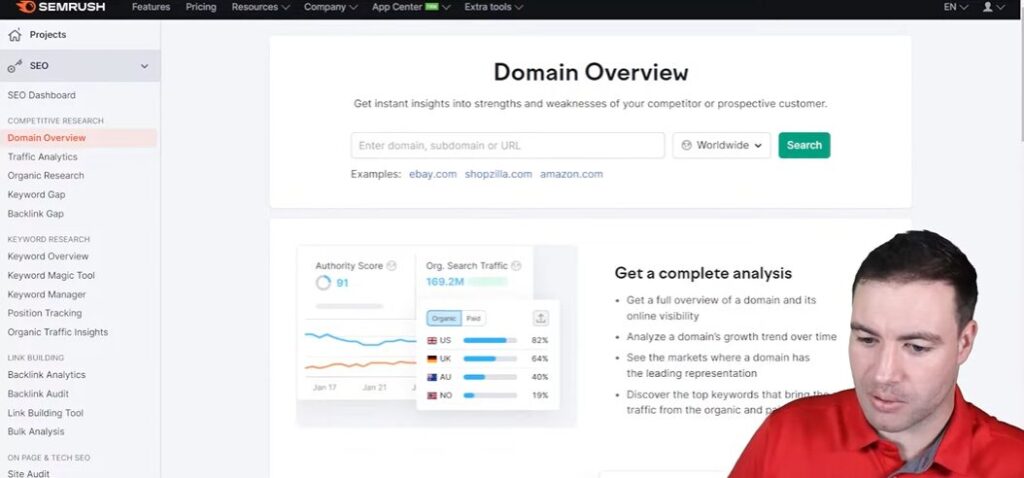
When it comes to analyzing traffic, using the right tools can help your website soar. SEMrush and ShineRanker are two of the most popular options. But which one is right for you? Let’s dive into the pros and cons of each tool, their cost comparisons, and how to navigate them for maximum benefit.
The price difference between SEMrush and ShineRanker is significant. SEMrush's monthly fee might deter smaller enterprises, while ShineRanker’s annual pricing is more approachable. However, it’s crucial to consider what you get with each.
SEMrush offers extensive reporting tools, which are perfect for robust analyses. On the flip side, ShineRanker has essential features that suffice for those starting out or focusing on improving local SEO. So, what are your needs?
Learning how to use these tools effectively can change the game. With SEMrush, you should:
With ShineRanker, the process is simpler:
Both tools have their strengths; it’s about knowing which one resonates with your goals.
In my experience, using both tools offers the best insight. SEMrush provides depth, while ShineRanker simplifies the journey. So, which will you choose? Remember, understanding your competitor’s traffic is crucial in today’s digital landscape. It’s all about making informed decisions.
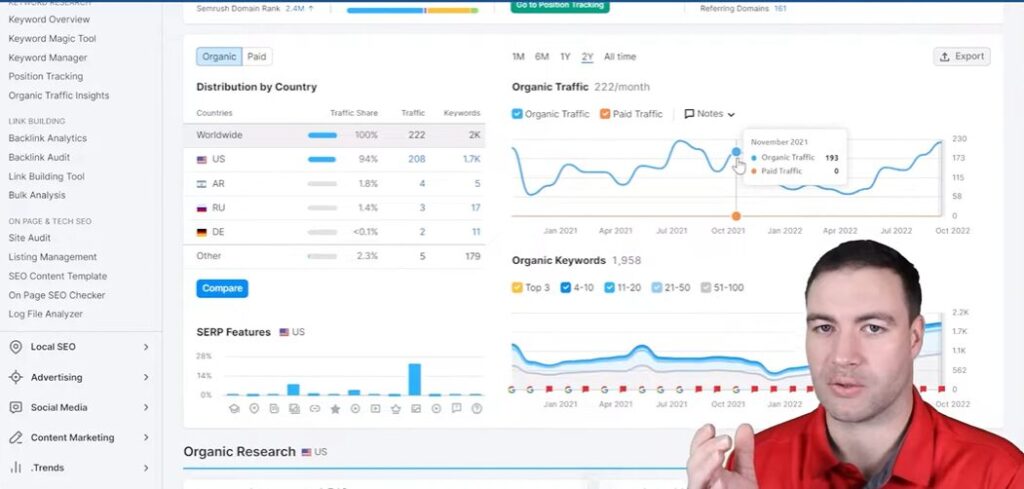
In our quest to understand the online landscape, examining a competitor's traffic is vital. It can reveal their secrets to success. So, how to check a competitors website traffic? Let’s break it down into manageable steps.
The first step is selecting a competitor. Your choice should be based on similar services or products. Maybe they have a strong online presence, or perhaps they rank for keywords you’re interested in. Once you have them in mind, it’s time to enter their domain into an SEO tool.
Consider using tools like SEMrush or ShineRanker. I often use ShineRanker for its affordability, especially for smaller businesses or those just starting with SEO. After entering the competitor's URL, you'll be amazed at what you can uncover!
Upon analyzing, you’ll see traffic estimations. For example, SEMrush might show a competitor with 5,000 monthly visits. However, keep in mind these are estimates. Surprisingly, the actual visits could be higher! That’s the beauty of these tools - they provide a glimpse into performance.
As I analyze, I often export this data to a spreadsheet. This allows me to apply filters and find out which content is working for them - making it easier to spot trends.
The next step is to dive into the SERP - Search Engine Results Pages. What's ranking on that page? It’s not just about clicks; it’s about strategy. For example, if I see a competitor's website capturing a significant portion of searches, I take note.
“Monitoring competitors’ traffic is not just about numbers but about strategies."
By understanding these elements, I can identify where opportunities lie. Are there keywords that my chosen competitor might be underutilizing? If so, I’m ready to act!
So, are you ready to start analyzing traffic like a pro? Let’s unleash the potential of your website by learning from others!
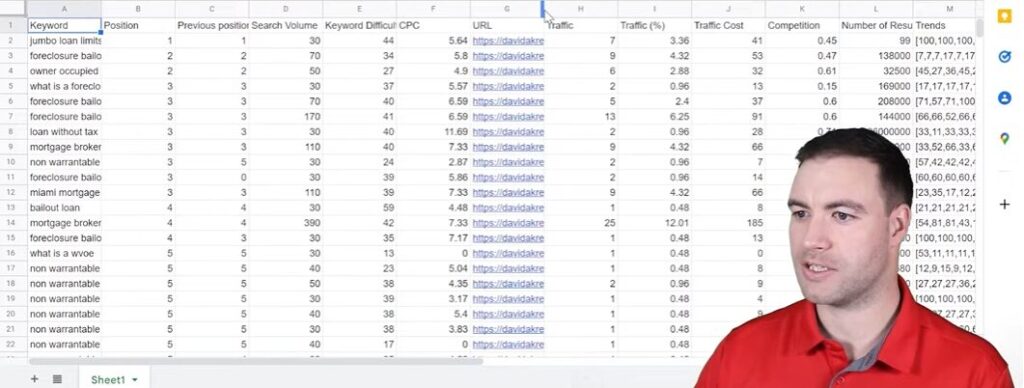
Once we gather data from our competitors, there's a lot we can do with it. Think of it as gold - it's valuable and can help us shine in our niche. So, where do we begin? Let’s break it down into three key strategies.
First, let’s talk about integrating competitor insights into our own strategy. By taking a closer look at our competitors, we identify what’s working for them. For instance, if a rival is excelling with particular keywords or content styles, we can adapt and customize those insights. Why reinvent the wheel when we can borrow success ideas? Remember, imitation is the best form of flattery. But we must ensure that we adapt these insights to fit our own brand voice and uniqueness.
Next, we focus on creating optimized content that targets untapped keywords. As we analyze data, we often uncover keywords our competitors might be overlooking. For example, let’s say we notice a competitor isn’t ranking for long-tail keywords related to their services. This is our opportunity! Writing content that fills this gap can drive significant traffic to our website. Instead of swimming with the big fish, let’s fish in a less crowded pond.
Lastly, we can't just set it and forget it. Continuous monitoring is key for ongoing optimization. The digital landscape shifts constantly. What works today might not work tomorrow. By keeping an eye on competitors’ traffic and strategies, we can make informed decisions. This involves regular checks on their content, the keywords they rank for, and their engagement metrics. And trust me, this will pay off in the long run. It’s about staying one step ahead.
So, why not? Let’s actively integrate our findings, seize those keywords, and keep our eyes wide open. That way, we aren’t just participants; we're leaders in our field. If we keep this up, success won’t just be a goal - it’ll be our reality.
As I reflect on how to check a competitors website traffic effectively, it's clear that understanding our competitors is more than just a numbers game. It's about unlocking strategies that have already been tested and proven in the market. The importance of competitive analysis cannot be overstated. By examining the successes (and failures) of others, we can adapt and refine our own digital marketing efforts.
Why is this vital? Think of it this way: envision you’re navigating a dark forest. You can either stumble through blindly or use a flashlight to illuminate the paths others have taken. The latter leads to quicker success. Competitive analysis serves as that flashlight. It allows us to identify keywords we may have overlooked and uncover strategies that can drive traffic to our sites.
One thing I've learned in my experience is that metrics are not just a one-time task. They should be integrated into our ongoing strategy. Data is dynamic; it changes, and so must we. Constantly tracking our competitors’ traffic and how they engage their audience helps us to stay relevant. Are your competitors achieving impressive click-through rates? What about conversion rates? By continually using metrics, we turn data into action and actionable insights. So, let's keep checking those numbers and don’t be afraid to pivot when necessary.
Now, as we look to the future of digital marketing, several considerations come to mind. First, enhancing our understanding of evolving algorithms. Google is always refining its standards, and we must keep up or risk being left behind. Second, remember the importance of organic traffic. Investing in quality content that resonates with your audience will continue to be a strong strategy. Engaging with your audience authentically fosters brand loyalty and long-term success.
In summary, competitive analysis, continual use of metrics, and a proactive approach to what lies ahead are key components to thriving in this ever-changing digital world. With these insights, we can transform data into actionable strategies that not only elevate our brands but also shape our future in digital marketing.
When I first dipped my toes into the realm of SEO, I was overwhelmed by all the jargon and strategies thrown my way. Backlinks, especially tiered backlinks, felt like a mystical concept that was just beyond my grasp. But as I learned and experimented, I realized how crucial these structures are for boosting online visibility. Today, I want to take you on a journey through the tiers of backlinks, sharing my insights, tips, and a few of the missteps I made along the way. I can assure you that these insight will surely help you create quality Search Engine Optimization strategies and tactics.
TL;DR: Understanding what are tier 2 backlinks is essential for effective SEO. Tier one backlinks link directly to your target pages, while tier two backlinks link to your tier one backlinks, amplifying their power. Let's explore how this structure can enhance your site's authority.
Backlinks are essential for SEO. They are links from one website to another, and they serve as a vote of confidence for your content. The more quality backlinks, the more search engines trust your website. But how do we categorize these backlinks? That’s where backlink tiers come into play.
Simply put, backlinks are links that point to your site from elsewhere on the internet. They’re vital because they can improve your search visibility. Think of backlinks as pathways leading potential visitors to your content. The more relevant and authoritative these pathways, the better your chances of ranking higher on search engine results pages (SERPs).
Tier One links, or T1 links, are the most valuable. They link directly to your target page. For instance, if I write a guest post on a reputable blog with a link back to my consulting page, that’s a T1 link. These links should come from high-quality sources in your niche. Why? Because a high-quality T1 link boosts your credibility, while a low-quality link can do the opposite.
Tier Two links, or T2 links, connect to your T1 links rather than directly linking to your target page. Their role is to enhance the power and visibility of the T1 links they support. You can get creative here; using social media platforms and Web 2.0 properties as T2 links can be effective. For example, if I share my guest post link on Facebook, I create a T2 backlink.
Finally, we have Tier Three links, or T3 links, which connect to your T2 links. Their purpose is to boost the authority of T2 links. I often use tools like GSA Money Robot for T3 links, especially for personal projects. These links can be generated in large volumes, but remember to use them wisely. They don't have to be high quality, but they should still maintain a coherent theme with higher-tiered links.
By understanding these tiers, we can build a more effective backlink strategy. It’s not just about throwing links at the wall and seeing what sticks. We need a structured approach that enhances our SEO efforts.
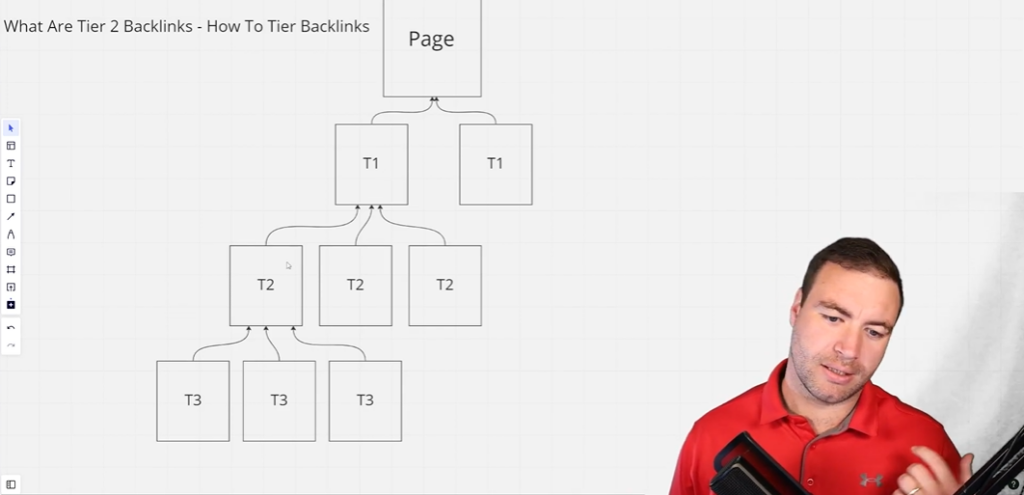
Backlinking is crucial in the SEO world. I recently dove into this topic and realized the importance of crafting a solid tiered backlink strategy. Let's break down the tiers and how we can maximize their effectiveness.
The first step in building our backlink strategy is to identify the right niches for Tier One (T1) backlinks. These are the main links pointing directly to your site. Think of T1s as the foundation of a house. If they're weak, the whole structure is at risk.
A T1 backlink should come from a reputable and relevant source. For instance, if your site focuses on "startup consulting," your T1 should ideally come from a well-established site in entrepreneurship or business. This relevance helps maintain authority.
But how do we find these niches? It starts with research. Use tools like Ahrefs or SEMrush to analyze competitors. The keywords they rank for can lead you to potential backlink sources.
Once we've secured our T1 links, it’s time to focus on Tier Two (T2). These links boost T1s. I find creativity pays off here. Social media platforms and Web 2.0 sites can serve as fantastic sources for T2 links.
These lower-cost options can amplify the strength of our primary links while making them feel more organic.
Next, we move to Tier Three (T3). These links support T2 links, providing volume and helping maintain relevance. Here, we can experiment a bit. T3s can be of lower quality; think of them as fillers that help reinforce the whole structure.
Tools like GSA Money Robot can be useful for generating T3 links. However, be mindful. Even though we want quantity, we shouldn’t sacrifice too much quality.
The most vital component in this entire strategy is relevancy. Every backlink we create should connect back to our main topic. If our T1 backlink uses the anchor text “startup consultant,” then T2 and T3 links should use similar themes.
This approach not only looks more natural to search engines but also creates a cohesive narrative for our backlink profile. Why risk losing hard-earned authority?
In my experience, focusing on these elements has provided a substantial boost to my SEO efforts. By keeping our tiers organized and relevant, we can strengthen our overall link profile efficiently.

When I first started with SEO, the concept of tiered backlinks felt overwhelming. I remember my initial attempts were riddled with confusion. I just wanted backlinks to boost my site. Little did I know that the quality of those links mattered more than sheer quantity. That's why it is important to know what are tier 2 backlinks.
Through trial and error, I began to understand the layered approach of tiered backlinks. Tier 1 (T1) links are my primary focus. These are links from reputable sites directly pointing to my target page. For instance, I worked hard to secure a guest post about startup consulting. This link became my strong T1.
Then came the T2 links. In my journey, I've faced both challenges and victories here. Initially, I thought T2s didn’t need to be robust. I grabbed links from any available site. However, this backfired. Some T2 links were spammy! They actually diluted the impact of my T1 links, pulling down my rankings.
Relevance has played a significant role in my backlinking strategy. I’ve learned that search engines are picky. They want links that make sense. When my T1 anchor text was “startup consultant,” my T2 and T3 links needed to reflect that theme. This consistency made my link profile look more legitimate.
Anchor text is like the main headline of your blog post. It grabs attention. The right choice can make or break SEO efforts. I discovered that if my T1 anchor text was generic, my T2 links would suffer. I kept it focused on niche-specific terms. This tactic not only improved relevancy but also set a solid foundation for T3 backlinks.
Ultimately, as I navigated this complex world of tiered backlinks, I found myself refining my strategies. Achieving the right balance between quality and quantity has been key. This way, I ensure that my site climbs the SERP ladder smoothly.

When it comes to backlink building, not all links are created equal. It's essential to understand how to structure your backlinks effectively. I've put together some best practices that can help us navigate the complexities of tiered backlink building.
First things first, let’s talk about Tier 1 links. These links are the foundation of your backlink strategy, so it’s crucial that they are high-quality, authoritative links. Think of them as the main pillars supporting your website. When you acquire Tier 1 backlinks, make sure they come from reputable sources - ideally within your niche. After all, wouldn't you want a recommendation from a respected expert in your field?
Next up, we have Tier 2 backlinks. While these can be a bit more flexible, it's still vital we maintain quality. Avoid spammy links like the plague. They can harm your site more than help it. Remember, the role of T2 links is to amplify the strength of your T1 links, so you want them to be credible and relevant.
Are we keeping an eye on indexing? This is something I find sometimes overlooked. Regularly check to ensure all your tiers stay active and relevant. If your T1 links lose their indexing, your entire backlink strategy could be jeopardized. Would you let a leaky roof ruin your home? Probably not!
Lastly, let’s not forget the importance of monitoring authority metrics. These metrics can inform our tiering decisions. Are our T1 links gaining authority, or are they stagnant? If we see a drop, it's time to reassess our strategy. After all, numbers don’t lie - so why ignore them?
In my experience, having a clear, methodical approach to tiered backlink building can make a world of difference. By focusing on quality at each tier, we can build a solid web of backlinks that will improve our SEO in the long run. So, let’s stay focused and keep those best practices in mind! Building links is just like building anything else; a strong foundation leads to success.
As we wrap this up, let's take a moment to appreciate the significance of understanding what are tier 2 backlinks. Just like building a strong foundation for a house, tiered backlinks form the backbone of effective SEO. When I first started exploring this concept, I realized how powerful it could be. Each tier adds a layer of authority to your website, enhancing its visibility on search engines.
Understanding how each tier works is vital. The Tier 1 (T1) links are your direct, high-quality backlinks. In my case, these often come from authoritative sites within my niche, like guest posts. This is where the strength lies. Without solid T1 links, your site could struggle to rank.
Then we have Tier 2 (T2) backlinks. While these can be less authoritative, they play a critical role. Think of T2s as the support team for T1s. They help amplify the power of your primary links. So, I encourage you to develop your own tiered backlink strategies thoughtfully. Experimenting with different approaches is key to finding what works best for you.
SEO is not static. It evolves, and so should our strategies. Continuous learning is vital. I’ve learned to adapt my backlink strategies several times based on changing algorithms and trends in digital marketing. Always stay informed and be ready to adjust your approach.
Ask yourself: are you staying current with best practices? As I mentioned, relevance is crucial. If a T2 or T3 link starts dragging down your T1's credibility, it could hurt your rankings. So, always aim to keep all backlinks credible and relevant.
"In the digital marketing world, adaptability is just as important as strategy." - Ron from Osborne Digital Marketing
In conclusion, understanding and implementing tiered backlink strategies is essential for building a robust SEO foundation. I hope you’re inspired to dive in and develop a tailored backlink strategy that suits your needs. Let's navigate the dynamic world of SEO together, learning and adapting as we go.
Have you ever wondered about the behind-the-scenes magic of improving your website's ranking? A few years back, I explored headfirst into the world of SEO and stumbled across something intriguing: Private Blog Networks, or PBNs. So, what are PBN links? At first glance, the concept seemed risky, but as I dug deeper, I realized that, like most things in life, there’s more than meets the eye. Join me as I unravel the nature of PBN links and uncover both their potential and pitfalls.
TL;DR: PBN links can significantly boost your website's SEO by providing controlled backlinks, but they come with risks that could lead to penalties from Google. In this post, read and learn what PBNs are, how to identify them, and their benefits and drawbacks.
Private Blog Network, or PBN, is an interesting topic in the world of SEO. So, what exactly is a PBN? Essentially, it’s a network of authoritative websites that are used to build backlinks for a particular site. They are links built from a network of privately owned websites to another site.These sites are not accessible to the public for regular browsing. They exist primarily to serve one purpose: boosting the rankings of a primary website, often referred to as the "money site." This is achieved through strategic link building.
To grasp the concept of PBNs, it helps to break it down into its components:
PBNs can significantly affect SEO rankings. When a PBN site links back to the money site, it creates a signal to search engines that the money site is credible and worthy of a higher ranking. Surely, you may wonder if this tactic is worth the risk? I can assure you, it's a double-edged sword!
On one hand, PBNs can help you achieve quick results in terms of backlink acquisition. Traditional link building can take weeks or even months, while PBNs can deliver instant traffic boosts. However, it’s essential to remember that they operate in a gray area of SEO practices. They are often categorized as a black hat tactic, which means they violate some of Google’s guidelines.
Backlinks play a crucial role in establishing a website's authority. They are a bunch of websites built for one purpose—to act as votes of confidence from one site to another. The more credible sites link to your money site, the better it will rank. So, what's the catch?
Using PBN links for your link building strategy can be tempting since they often come at a lower price than premium backlinks. For example, while premium links can cost over $100 each, PBN links might range from $30 to $60. But, is saving money worth the potential penalties from Google if detected?
Analyzing quality is vital to achieve good link building results. If you have a PBN with thousands of outgoing links but only a handful of referring domains, it's time to raise your eyebrows. Ron from Osborne Digital Marketing reminds us that keeping an eye on the metrics is essential. It separates successful PBNs from those that could lead to trouble.
In conclusion, while PBNs can offer fast results and control over backlinks, they also come with inherent risks. The balance between quick rewards and potential penalties should be carefully weighed by anyone considering this strategy for their link building and website’s SEO.
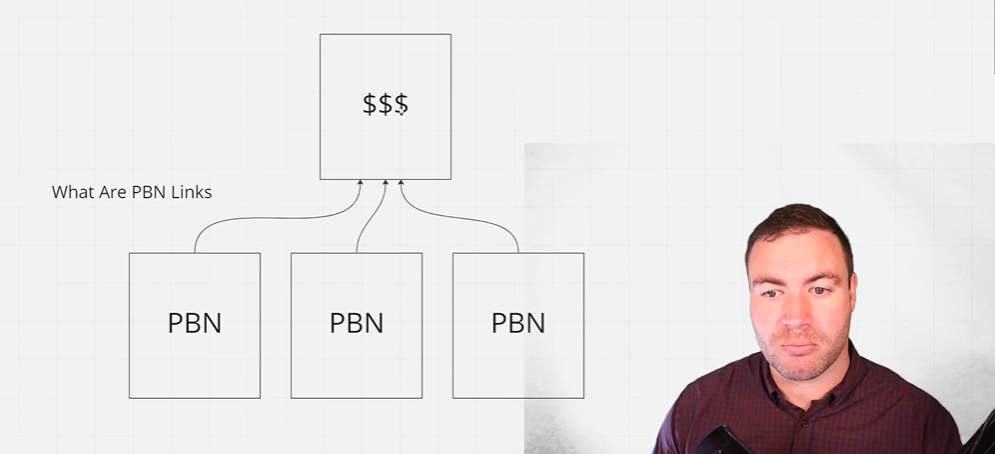
In today's digital marketing industry, using Private Blog Networks is becoming a popular link building strategy for many marketers. But why is that? Let’s dive into what are PBN links and their advantages.
One of the standout advantages of PBNs is the complete control they offer over your link building strategy. Imagine having the power to decide where your links go, how they are structured, and even the content that surrounds them. This level of control means you can tailor your efforts specifically to your target audience. You’re not at the mercy of other websites’ decisions.
Link building through traditional methods often involves a lengthy process. This could take weeks of outreach and negotiation. With PBNs, however, obtaining backlinks can be almost instantaneous. I’ve seen projects where links are acquired within days. Isn’t that incredible?
When it comes to budgeting, PBNs stand out as a cost-effective solution. While premium backlinks can set you back anywhere from $200 to $1,000, links through PBNs typically range between $30 to $60. Don't you think it makes sense to get more value for less? It’s a win-win situation!
PBNs allow for precise targeting of niche-specific content. This is crucial for improved engagement with your target audience. If you're in a specialized field, positioning yourself with relevant content is key. With PBNs, you can create links that are exactly aligned with your niche, enhancing your website's authority.
So, have you considered how these advantages could benefit your own link building and digital marketing strategy? The potential is boundless with the right approach.
PBNs can effectively enhance your website's SEO when used properly. Just remember, while they offer fantastic opportunities, it is essential to manage them wisely. Are you ready to take control of your online presence?

When it comes to identifying high-quality Private Blog Networks (PBNs), there are several key factors you must consider. Trust me, I’ve spent a considerable amount of time analyzing various PBNs and understanding the nuances involved. Let’s explore into this guide of what makes a PBN stand out or fall flat.
First off, there are some key indicators that signal whether a site is part of a PBN. You might ask: what should I look for? Here are a few signs to keep an eye on:
Why do these elements matter? Consider this: a robust "About" page conveys transparency. It builds trust with users. Similarly, having contact information is crucial. When it's absent, it raises questions. Who's behind the site? What are their intentions? Without these pages, a site can appear shady.
Next, let's talk about social signals and user engagement. Engaging content typically generates likes, shares, and comments. If you notice a PBN site getting a mere trickle of engagement - or worse, none at all - this could be a sign that the site isn’t legitimate. It’s not enough to have a great-looking layout; the audience's reaction should matter too.
Finally, it’s vital to utilize tools for referral link analysis. There are various SEO tools out there that can help you evaluate a site’s link profile. For example, if you find a PBN with 1,000 referring domains but 10,000 outgoing links, that screams “something isn’t right!” You can also check for spammy backlinks or a lack of diversity in the sites linking to them.
Remember, the more transparent a PBN is, the better your chances of deciding if it’s worth your time. Always assess each site on a case-by-case basis.
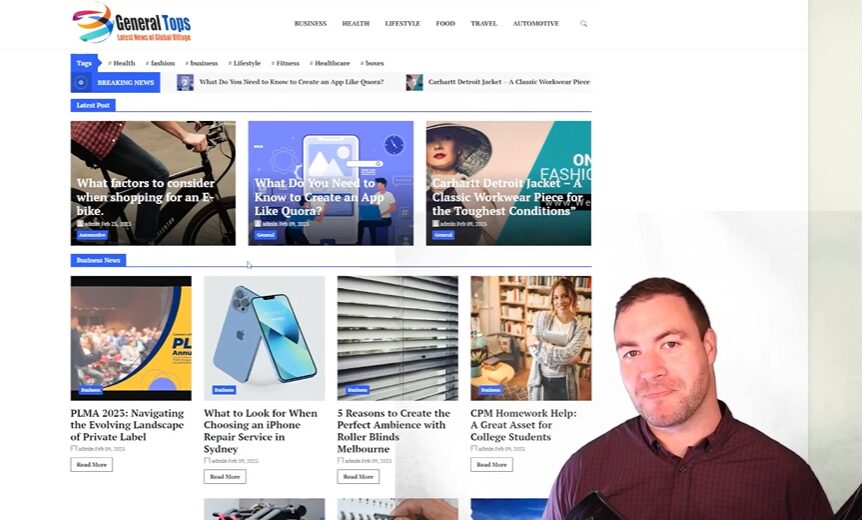
PBNs, or Private Blog Networks, have a certain appeal in the world of SEO. They are not considered as white label SEO tactics but they promise quick results and an easy way to boost your website's rankings on Google search results. But before you jump in, let's take a closer look at the cons and risks.
First off, PBNs are widely viewed as black hat SEO tactics. What does that mean? It's a way of manipulating search rankings by using unethical practices. Imagine trying to cheat in a game - sure, it might work for a while, but eventually, you're going to get caught. Google has strict guidelines, and PBNs definitely slip into that gray area.
Next, let's talk about penalties. A PBN link can lead to serious consequences. Google is always on the lookout for sites trying to game their system. If they catch you using a PBN, your site's ranking could tumble. That's a lot of work down the drain!
Another risk of PBNs is their inconsistent quality. Not all PBNs are created equal. Some might boast strong link metrics, while others could be filled with spammy links. If you're not careful, you might end up linking to low-quality sites that could damage your credibility. A few bad links can ruin your hard-earned reputation and your link building plans.
We need to examine the link metrics closely. One indicator to watch for is an imbalance of links. For instance, if a PBN has 1,000 referring domains but 10,000 outgoing links, it’s a red flag screaming for scrutiny.
Lastly, there's the question of sustainability. Can you rely on PBNs for long-term success? In my experience, the answer is often No. SEO is always evolving. What works today may not work tomorrow. Building a PBN can be costly and time-consuming, and in the end, it might not pay off. It’s a high-risk strategy that could lead to unstable rankings.
Ultimately, while PBNs may offer a shortcut to improved SEO, the risks can outweigh the rewards. Always remember to play smart and stay within the rules. Your online reputation is worth much more than a quick boost in rankings.

Private Blog Networks (PBNs) are often seen as a tempting shortcut in the world of SEO. But to me, using them effectively requires a nuanced approach. We must approach with caution. Why? Because the risk of penalties from Google is very real. With PBNs, you could elevate your website quickly, but it's crucial to ensure you're not biting off more than you can chew.
It's essential to remember that PBNs are often labeled as black hat SEO tactics. Using them might feel like a quick win, but the potential downsides can haunt you. Think of it this way: would you rather have a 100% success and risk a penalty or take a longer route that's safer and sustainable? It's a choice we all must consider.
Once you start using a PBN, don't just set it and forget it. Regular audits and link monitoring are necessary to keep tabs on PBN performance. Check metrics such as traffic and domain authority. This way, you can ensure that your PBN is not only functional but also effective. Ask yourself: are these sites genuinely driving traffic and boosting my main site’s SEO? If not, it might be time for a reassessment.
Don't rely solely on PBNs. We should all be combining them with legitimate outreach methods. This means reaching out for guest blogs or collaborating with others in your niche. Imagine a recipe that calls for both spices and vegetables for the best flavor. Similarly, mixing PBN use with credible outreach can lead to a richer SEO strategy. You’ll build natural links that search engines appreciate.
PBNs shouldn't be the only tool in your kit. Instead, think of them as one part of a larger strategy. Incorporating PBNs within a comprehensive SEO approach can yield better results. I’ve always believed that true success lies in the balance. This might include content marketing, social media, and organic link building. As Ron from Osborne Digital Marketing points out, “effective SEO has always revolved around content and links.”
Acquiring domains for a Private Blog Network requires a few strategic steps. First, you need to find expired or auctioned domains that have strong metrics, like high domain authority and relevant PBN backlinks. Using tools, such as Rank Lightning and Ahrefs, that analyze domain history and performance can help you choose domains that will boost the PBN's effectiveness.
After identifying suitable domains, the next step is to buy them from reputable registrars or auction platforms. It's important to make sure that the domains have clean histories, free from penalties or spam associations, to keep the PBN link's integrity intact. Conducting proper due diligence during this process will greatly contribute to the overall success of the network.
Engaging in PBN strategies is not for the faint-hearted. Yet, if we tread carefully, leverage audits, integrate with outreach methods, and maintain a broader SEO strategy, we can navigate the complexities of PBN links successfully. Just remember to stay vigilant!
As I reflect on the journey through the Private Blog Networks (PBNs) landscape, it's essential to recap the key points discussed. PBN links can be a double-edged sword in the world of SEO. On one side, they offer a potent tool for boosting your website's authority through backlinks. The visual differences between a "money site" and a PBN website provide a clear distinction of how these networks function. A well-crafted PBN can drive quicker results than traditional link building, which often takes time and effort.
However, I can't overlook the inherent risks. Engaging in PBN strategies can easily be perceived as a black hat tactic. This could potentially lead to penalties from search engines like Google. The absence of critical features, like an "About" page or social media links, often hints at the presence of a PBN. I’ve come to learn that while PBNs can be an attractive shortcut, they require vigilance and a keen analytical eye to avoid pitfalls.
Personally, I find PBNs to be a tempting strategy in my digital marketing toolbox. They provide a unique avenue to control and influence where my links point. But, I’m also cautious. As Ron from Osborne Digital Marketing emphasizes, the quickest results aren’t always the safest. Now you know what are PBN links.
What does the future hold for SEO and backlink strategies? It’s becoming increasingly clear that quality will always triumph over quantity. While PBNs might provide a quick fix, maintaining a robust and thriving online presence will rely more on fundamental SEO practices, like content quality and ethical link building. As search algorithms evolve, our approaches must adapt to remain compliant and gain real, lasting advantages.
In conclusion, navigating the PBN landscape requires a balance of risk and reward. By staying informed and cautious, I believe we can leverage the benefits of PBNs while steering clear of their darker sides. I look forward to exploring more about this topic and sharing my insights with you all.
When I first launched my digital marketing agency, I found myself in a perplexing situation - my newly created website seemingly disappeared into thin air, trapped in what SEO experts call the 'Google Sandbox.' I remember the feeling of frustration as I typed my own website name into Google, only to see nothing but a blank page. Little did I know, this was just a rite of passage for new websites trying to prove their worth.
TL;DR: Unlock the secrets on how to get out of the Google Sandbox by creating rich content, building a brand presence, and utilizing effective marketing strategies for small businesses looking to boost their online visibility.
The Google Sandbox is a term used in the SEO community to describe a phenomenon experienced by new websites. When you launch a new site, it often struggles to achieve high rankings right away. This happens because Google takes its time to evaluate your site’s credibility - a process that feels a bit like being put in a waiting room.
For new website owners, understanding the Sandbox is crucial. Imagine this: You’ve just built your dream site, excited to see it thrive. But then, you search for your brand name, and it's nowhere to be found. This situation can feel frustrating and disheartening. Knowing about the Sandbox helps set realistic expectations. It's essentially the price you pay for starting fresh online.
Now that we know what the Sandbox is, we can discuss how it impacts our SEO strategies as new website owners. The delay can force us to refine our approaches. Here’s how:
This knowledge equips us as website owners. Rather than feeling stuck, we can take proactive steps to weather the Sandbox storm. It takes patience, but every action we take contributes to our long-term success.

Have you ever wondered why some websites seem to magically rank higher on Google? One key factor I’ve found is having over 100 unique pages of content. It’s a significant milestone. Why? Because Google appreciates dedication. When you showcase a wealth of information, it signals that your site is credible and worth exploring. I encourage you to consider the daunting task of writing so much content as an opportunity rather than a burden.
Now let’s dive into how to create that valuable content. Here are some essential tips:
It’s key to note that just writing a lot isn't enough. Each piece of content should hold value. Think about the reader's journey and how your content can guide them.
To provide some context, I have seen clients flourish by implementing strong content strategies. For instance, I had a client who created a blog dedicated to eco-friendly living. They produced over 120 articles! This effort drew a steady audience and built a community. It wasn’t overnight success, but consistency paid off.
Furthermore, variety is crucial in your content creation strategy. Google favors a mix of text, videos, and infographics. Why? It keeps users engaged. Think about it like a buffet. If you only had one dish, wouldn't you get bored quickly? Here’s what I suggest:
Using diverse content showcases your site’s versatility. Remember, SEO is more than just keywords. It's about user experience too.
I encourage you to craft a robust content strategy. The more you create, the more your authority builds. Let’s break free from the constraints together and step into a world of content-rich opportunities!

When I think about establishing a brand, I reflect on the significance of branded assets. They are not just logos or taglines. Branded assets are essential tools in helping to build your search engine optimization (SEO) strategy. They signal to Google that you are legitimate and trustworthy.
This is crucial. Google wants to rank websites that provide value. Therefore, if you can show that you have a strong brand presence, it enhances your chances of climbing up those search result rankings.
How can we establish our brand in today’s crowded digital market? Here are some key strategies:
Each of these efforts adds to your overall online presence, making Google more likely to see you as an authoritative brand.
Have you thought about how social media could enhance your SEO? It’s more than just posting updates. It’s about creating backlinks to your site. Here’s how I leverage social media:
Now, let’s discuss the importance of creating a network of links. Establishing a cluster of quality backlinks is instrumental for SEO.
Why? Because good links act as endorsements. They tell search engines that your site is a credible source. So, how do we build this network? Here are some points to remember:
It all comes down to connecting your site to others, creating a strong digital footprint. This credibility not only helps with your ranking in search results. It enhances your brand authority and helps you on how to get out of the Google Sandbox.
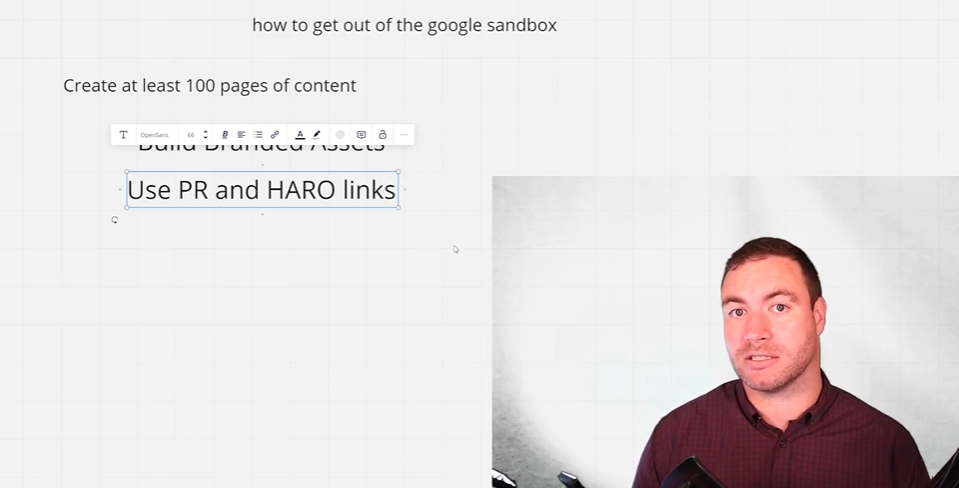
When I mention PR links, I'm talking about links that originate from press releases. These are statements issued to the media to attract coverage. They can significantly boost your visibility. Now, HARO stands for Help a Reporter Out. It's a fantastic platform where journalists seek expert sources for their stories. When you provide valuable insights, you can earn a link back to your site.
So, why should you care? Because both PR and HARO links can elevate your online presence! They not only drive traffic but also improve your site’s authority. Think of this as having a strong recommendation - everyone loves a good reference!
The cost associated with press releases can vary greatly. You might pay for distribution services or even hire a professional writer. But, are these expenses worth it? I’d argue yes. Press releases can reach a broad audience. They can deservingly put your business in front of potential clients.
In fact, I've seen clients double their traffic after a successful press release campaign. It’s a game changer!
Having links from reputable sources like Forbes or CNN can give your site an instant boost. It’s like being invited to an exclusive club. When Google sees high-quality links pointing to your site, it often interprets this as a sign of credibility.
Plus, let’s face it: nobody wants to be in the sandbox forever! Those PR and HARO links can help lift you out, paving the way for higher rankings. So, consider these links as stepping stones that lead to better standings.
I'll never forget a campaign I worked on with a local service company. We invested in a press release, and to our surprise, it landed on a major news outlet. Within days, their traffic spiked. Customers were calling from all over! It showed me firsthand how powerful PR links could be.
Then there was that one instance where I contributed to a HARO request. My quote made it into a popular magazine, and guess what? I ended up receiving multiple inquiries from potential clients. This made me realize I was onto something big. So I ask: why not dive into this? You never know what doors may open!

When it comes to driving traffic to your website, both PPC (Pay-Per-Click) advertising and social media marketing are invaluable tools. I’ve learned that while organic reach can be slow, PPC can give you that instant boost. Think about it: with PPC, you're essentially paying to place your website at the top of search results or in feeds of potential customers.
But, why stop there? Combining PPC with SEO and social media ads can amplify your results even further. Imagine reaching your audience across multiple platforms, like Facebook and Instagram, all while driving traffic to your site at the same time. It’s effective, and it can help get your brand in front of a broader audience quickly.
Each social media platform offers unique advantages. For instance, Facebook is excellent for targeting specific demographics with detailed options, while Instagram's visual format is perfect for brands that can showcase their products beautifully. And let’s not forget about TikTok! It's a lively platform that has the potential to go viral.
I've found that platforms can differ significantly in effectiveness depending on your objectives. Are you aiming for brand awareness? Or perhaps you want to generate leads? Knowing what you want can guide your choice. For instance, LinkedIn is great for B2B traffic, while Pinterest can be a goldmine for DIY and crafting niches. It’s all about choosing the right tool for your specific goal.
In my experience, using paid ads is one of the fastest ways to build an audience. You’ll want to create targeted ad campaigns that speak directly to your ideal customer. By doing this, you can attract the right followers who are more likely to engage with your content. The key here is to continually analyze and adjust your campaigns for optimal results. Keep asking yourself: Are these ads resonating? If not, it’s time to pivot and try something new!
Let’s look at some real-life examples that highlight success. One local coffee shop used Facebook ads to promote their new seasonal special. They targeted locals, and within a week, foot traffic significantly increased. Things like offering discounts or giveaways can sometimes create urgency, encouraging immediate action.
Another example is a fitness apparel brand that utilized Instagram Stories ads. They showcased vibrant visuals of athletes wearing their gear. The result? A viral campaign that not only generated traffic but also boosted their online sales by over 30%. Can you envision the impact of a well-crafted ad? It can be staggering!
Using social media to drive traffic isn’t just about these strategies; it’s about consistency and adaptability. You need to be ready to analyze what works and change what doesn’t. In this digital age, staying flexible is key. So, as you embark on your journey, remember to test, iterate, and most importantly, stay engaged with your audience. The rewards can be significant. These are the effective ways on how to get out of the Google Sandbox.